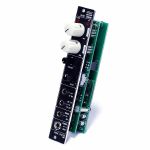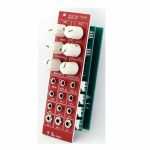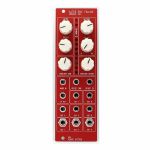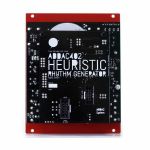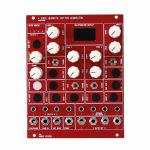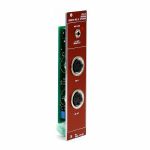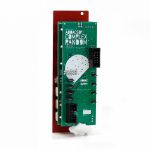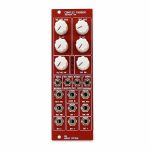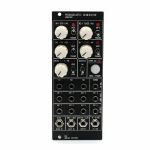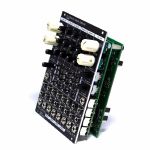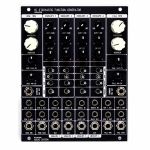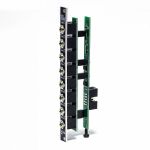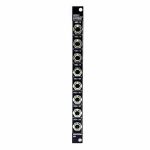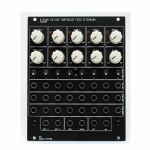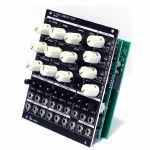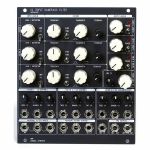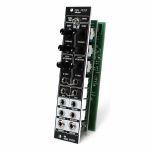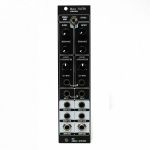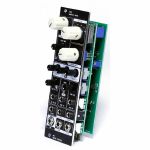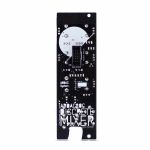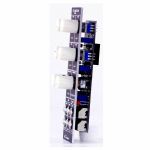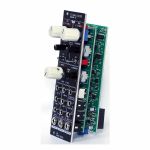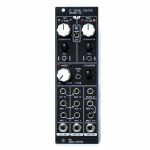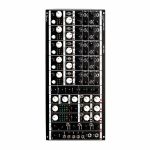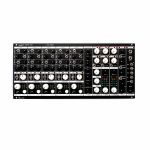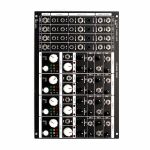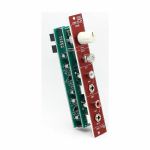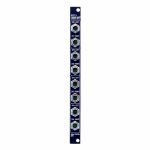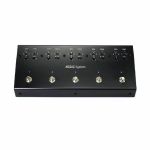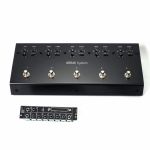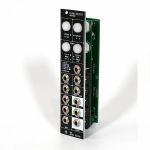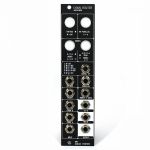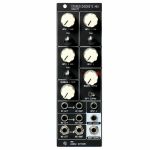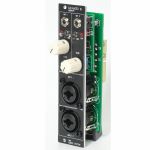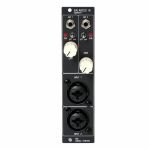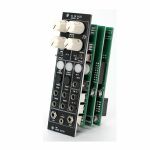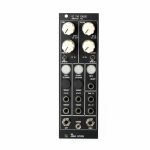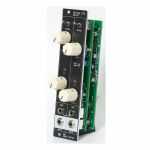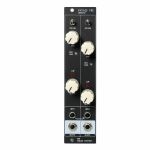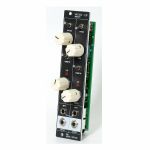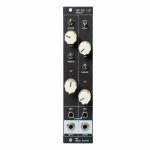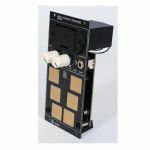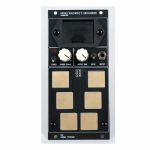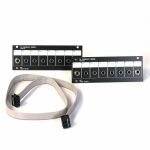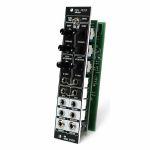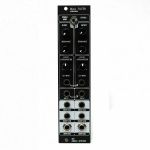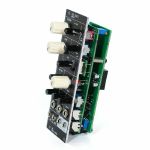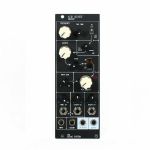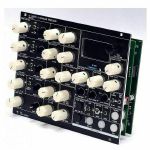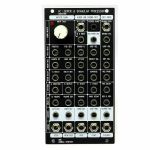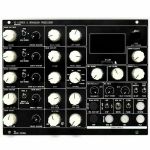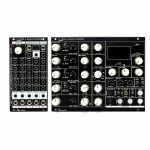100% Secure Shopping
Studio equipment
Our full range of studio equipment from all the leading equipment and software brands. Guaranteed fast delivery and low prices.
100% Secure Shopping
DJ equipment
Our full range of DJ equipment from all the leading equipment and software brands. Guaranteed fast delivery and low prices. Visit Juno DJ
Filter
Stock
Coming Soon
Format
Brand
Featured
Price
Tags
ADDAC System ADDAC307 Heart Sensing Module (black) (clock generator/controller/envelope generator/external synth module)
Cat: 776307 Rel: 08 Sep 20 • View all Synth modules
Heart sensing module
Notes: Another addition to the ADDAC300's Expressive Controls Series.
Preceded by the release of the ADDAC303 Muscle Sensing module, this is the second module made to take advantage of the physical body as a control source.
This module originated from a simple idea: using one's heart beat as a control source.
Using a clip-on sensor, that can be attached to a finger or an ear lobe, the user's heart rate will be aquired by sensing the blood flow passing under the sensor. This pulse will generate a trigger and an AD envelope.
Clip-on sensor will be provided with the module.
Tech Specs:
4HP
3.5cm deep
60mA +12V
10mA -12V
… Read morePreceded by the release of the ADDAC303 Muscle Sensing module, this is the second module made to take advantage of the physical body as a control source.
This module originated from a simple idea: using one's heart beat as a control source.
Using a clip-on sensor, that can be attached to a finger or an ear lobe, the user's heart rate will be aquired by sensing the blood flow passing under the sensor. This pulse will generate a trigger and an AD envelope.
Clip-on sensor will be provided with the module.
Tech Specs:
4HP
3.5cm deep
60mA +12V
10mA -12V
out of stock $166.06
ADDAC System ADDAC401 Gated Envelope Follower VS2 Module (red) (envelope follower/utility synth module)
Cat: 776309 Rel: 08 Sep 20 • View all Synth modules
Envelope follower module
Notes: With the ADDAC401 Envelope Follower you'll be able to use the volume of any sound source to control your synthesis.
This envelope follower has an interesting twist: besides outputting the volume information through a regular CV output, it also sports 8 independent gate outputs, triggered by the corresponding levels of the VU meter.
You can also control the offset on the gated outputs, either by CV or by steps through a special dedicated gate input.
Input Level and Decay controls allow you to achieve good envelope follower amplitude reaction.
Envelope Gain and Offset allows to set the envelope CV output to any desired CV range.
Monitor Leds for both the CV output and for the digital detection circuit.
Mechanical:
- Format: Eurorack
- Width: 8 HP
- Depth: 4.5 cm
Control Voltage I/O:
. CV output: i10v
. Gate input: 0 - 5v (threshold: 2.5v)
. Gate outputs: 0 - 5v
Electrical:
. Max current: 110mA +12v & 20mA on -12V
. Bus Board Cable: 8 × 2 IDC (Doepfer style) connector
… Read moreThis envelope follower has an interesting twist: besides outputting the volume information through a regular CV output, it also sports 8 independent gate outputs, triggered by the corresponding levels of the VU meter.
You can also control the offset on the gated outputs, either by CV or by steps through a special dedicated gate input.
Input Level and Decay controls allow you to achieve good envelope follower amplitude reaction.
Envelope Gain and Offset allows to set the envelope CV output to any desired CV range.
Monitor Leds for both the CV output and for the digital detection circuit.
Mechanical:
- Format: Eurorack
- Width: 8 HP
- Depth: 4.5 cm
Control Voltage I/O:
. CV output: i10v
. Gate input: 0 - 5v (threshold: 2.5v)
. Gate outputs: 0 - 5v
Electrical:
. Max current: 110mA +12v & 20mA on -12V
. Bus Board Cable: 8 × 2 IDC (Doepfer style) connector
out of stock $278.16
Cat: 776311 Rel: 08 Sep 20 • View all Synth modules
Rhythm generator module
Notes: This module is a powerful rhythm generation machine- it features 4 voices of gate outputs (including inverted outputs for logic NOT sequences) where each voice can have independent lengths, all configurable with direct knobs anc cv inputs.
Perfect for precise polyrhythmic patterns and all sorts of non-linear sequencing.
The module works by 6 different rhythm generation "algorithms / principles":
Euclidean (equal distribution)
Golomb Rulers (inequal distribution)
Probabilistic (predictable distribution)
Game Of Life (organic progression)
Footwork'n (inducted error progression)
Pong (voltage controlled Pong game)
Plus a 4 channel Gate Sequencer Mode with up to 32 steps and 16 storable presets.
Add ADDAC402B Expansion for full I/O Midi control plus access to a powerful midi interface, with:
Midi Sync
5 cv to midi channels (notes and/or cc)
4 midi to gate channels
All panel controls (knobs, switches and push buttons) as cc controls.
All fully configurable with a midi learn feature for easier configuration.
MECHANICAL:
Format: Eurorack
Width: 20 HP
Depth: 5.5 cm
CONTROL VOLTAGE I/O:
CV inputs: 0 to +10v
ELECTRICAL:
Max current: 150mA
Bus Board Cable: 8 × 2 IDC (Doepfer style) connector
… Read morePerfect for precise polyrhythmic patterns and all sorts of non-linear sequencing.
The module works by 6 different rhythm generation "algorithms / principles":
Euclidean (equal distribution)
Golomb Rulers (inequal distribution)
Probabilistic (predictable distribution)
Game Of Life (organic progression)
Footwork'n (inducted error progression)
Pong (voltage controlled Pong game)
Plus a 4 channel Gate Sequencer Mode with up to 32 steps and 16 storable presets.
Add ADDAC402B Expansion for full I/O Midi control plus access to a powerful midi interface, with:
Midi Sync
5 cv to midi channels (notes and/or cc)
4 midi to gate channels
All panel controls (knobs, switches and push buttons) as cc controls.
All fully configurable with a midi learn feature for easier configuration.
MECHANICAL:
Format: Eurorack
Width: 20 HP
Depth: 5.5 cm
CONTROL VOLTAGE I/O:
CV inputs: 0 to +10v
ELECTRICAL:
Max current: 150mA
Bus Board Cable: 8 × 2 IDC (Doepfer style) connector
out of stock $473.28
Cat: 776312 Rel: 08 Sep 20 • View all Synth modules
MIDI expansion module
Notes: ADDAC402B MIDI Expansion allows full I/O Midi control of ADDAC402 plus access to a powerfull midi interface, with:
Midi Sync:
Allows the module to synchronize with any external MIDI device’s Clock, including transport messages like play, stop and continue.
CV to MIDI:
5 CV inputs (Fills 1 to 4 and Assign) to MIDI Notes and/or CC messages, the Note and CC number can be independently configured via the Configuration Menu.
These CV inputs can be sent on independent MIDI Channels, for ex: Fills 1 to 4 on MIDI Channel 1 and Assign on MIDI Channel 2.
MIDI Controller:
All panel controls (9 knobs, 4 toggle switches and 11 push buttons) can be sent to MIDI Out as CC controls as any standard MIDI controller. The individual CC numbers can be configured through the Configuration Menu.
MIDI to Gate:
All 4 Gate outputs can be controlled/sequenced from an external MIDI device.
For ex: we can configure Gate 1 to be responsive to CC 1, Gate 2 to CC 2 and so on. Everytime CC 1 gets a value of 127 Gate 1 will be turned ON, if it gets a 0 value Gate 1 will be turned OFF.
MIDI Control:
All panel controls (9 knobs, 4 toggle switches and 11 push buttons) can be controlled/sequenced from MIDI CC controls. This allow full automation of the module via MIDI
The individual CC numbers can be configured through the Configuration Menu and includes a midi learn feature for easier configuration.
Also controllable via MIDI is the change of Presets and Modes.
… Read moreMidi Sync:
Allows the module to synchronize with any external MIDI device’s Clock, including transport messages like play, stop and continue.
CV to MIDI:
5 CV inputs (Fills 1 to 4 and Assign) to MIDI Notes and/or CC messages, the Note and CC number can be independently configured via the Configuration Menu.
These CV inputs can be sent on independent MIDI Channels, for ex: Fills 1 to 4 on MIDI Channel 1 and Assign on MIDI Channel 2.
MIDI Controller:
All panel controls (9 knobs, 4 toggle switches and 11 push buttons) can be sent to MIDI Out as CC controls as any standard MIDI controller. The individual CC numbers can be configured through the Configuration Menu.
MIDI to Gate:
All 4 Gate outputs can be controlled/sequenced from an external MIDI device.
For ex: we can configure Gate 1 to be responsive to CC 1, Gate 2 to CC 2 and so on. Everytime CC 1 gets a value of 127 Gate 1 will be turned ON, if it gets a 0 value Gate 1 will be turned OFF.
MIDI Control:
All panel controls (9 knobs, 4 toggle switches and 11 push buttons) can be controlled/sequenced from MIDI CC controls. This allow full automation of the module via MIDI
The individual CC numbers can be configured through the Configuration Menu and includes a midi learn feature for easier configuration.
Also controllable via MIDI is the change of Presets and Modes.
out of stock $92.38
ADDAC System ADDAC501 vs2 Complex Random Module (red) (random/CV modulation synth module)
Cat: 776328 Rel: 08 Sep 20 • View all Synth modules
Random CV generator module
Notes: The ADDAC501 does random CV generation and outputs it through four independent channels. You can control the desired range of voltages and time frequency at which new values are generated.
It can also be triggered by an external CV source and the output voltages can be either free or quantized (if you prefer to have a standard C Major scale).
Finally you can choose between pure randomness or a brownian distribution, for both the voltage and time intervals.
Mechanical:
- Format: Eurorack
- Width: 8 HP
- Depth: 5 cm
Control Voltage I/O:
- CV inputs: 0 - 10v
- CV output: 0 - 5v (0 - 10v through jumper)
- Gate in threshold: 2.5v
Electrical:
- Compatible with +-12v and +-15v power supplies
- Max current: 150mA
- Bus Board Cable: 8 × 2 IDC (Doepfer style) connector
… Read moreIt can also be triggered by an external CV source and the output voltages can be either free or quantized (if you prefer to have a standard C Major scale).
Finally you can choose between pure randomness or a brownian distribution, for both the voltage and time intervals.
Mechanical:
- Format: Eurorack
- Width: 8 HP
- Depth: 5 cm
Control Voltage I/O:
- CV inputs: 0 - 10v
- CV output: 0 - 5v (0 - 10v through jumper)
- Gate in threshold: 2.5v
Electrical:
- Compatible with +-12v and +-15v power supplies
- Max current: 150mA
- Bus Board Cable: 8 × 2 IDC (Doepfer style) connector
out of stock $322.78
ADDAC System ADDAC501B Complex Random Expansion Module (red) (expander synth module)
Cat: 776329 Rel: 08 Sep 20 • View all Synth modules
Expansion module
Notes: The ADDAC501B expansion is connected directly to the ADDAC501 Complex Random. It extends functionality by adding gate outputs to the random generators.
If ADDAC501 generates a new random above the average between Minimum and Maximum, then the respective gate on ADDAC501B is triggered.
There are three pairs of gates, corresponding to the respective outputs on ADDAC501. Each gate pair has both positive and inverted outputs.
This expansion module also offers a dedicated knob for gliding effects. With it you can have a voltage ramp between two consecutive random numbers- randomized "legato" expressiveness.
Mechanical:
- Format: Eurorack
- Width: 4 HP
- Depth: 5 cm
Control Voltage I/O:
- Gate outputs: 0 - 5v
Electrical:
- Connects directly to ADDAC501
- Max current: 20mA
… Read moreIf ADDAC501 generates a new random above the average between Minimum and Maximum, then the respective gate on ADDAC501B is triggered.
There are three pairs of gates, corresponding to the respective outputs on ADDAC501. Each gate pair has both positive and inverted outputs.
This expansion module also offers a dedicated knob for gliding effects. With it you can have a voltage ramp between two consecutive random numbers- randomized "legato" expressiveness.
Mechanical:
- Format: Eurorack
- Width: 4 HP
- Depth: 5 cm
Control Voltage I/O:
- Gate outputs: 0 - 5v
Electrical:
- Connects directly to ADDAC501
- Max current: 20mA
out of stock $128.70
ADDAC System ADDAC503 Marble Physics Module (red faceplate) (synth module)
Cat: 776332 Rel: 08 Sep 20 • View all Synth modules
Marble physics module
Notes: Newtonian physics on a modular synth! The ADDAC503 Marble Physics is a CV generator based on the mechanics behavior of a marble on a tray.
Through this realtime physics simulator you'll be able to control several parameters that will affect the behavior of a model of a spherical object against a plane. You can tilt the plane or bump the marble with a certain strength, which will cause it to roll and bounce on elastic walls.
The model will output the object's XY position or velocity and you can control other physical parameters, like the walls' elasticity or the strength of a bump. When the marble hits walls the bounce output triggers and you can additionally lock the X axis for a one dimension simulation. Finally you can also set the overall speed of the simulation.
By controlling all of these properties you be able simulate several scenarios where the marble falls, gets gently pulled by gravity, orbits indefinitely or bounces on walls like a pinball. Truly engaging physics simulations!
Mechanical:
. Format: Eurorack
. Width: 10 HP
. Depth: 5.2 cm
Control Voltage I/O:
. CV inputs: i 10v
. CV outputs: i 5v
Electrical:
. Max current: 150mA
. Bus Board Cable: 8 × 2 IDC (Doepfer style) connector
… Read moreThrough this realtime physics simulator you'll be able to control several parameters that will affect the behavior of a model of a spherical object against a plane. You can tilt the plane or bump the marble with a certain strength, which will cause it to roll and bounce on elastic walls.
The model will output the object's XY position or velocity and you can control other physical parameters, like the walls' elasticity or the strength of a bump. When the marble hits walls the bounce output triggers and you can additionally lock the X axis for a one dimension simulation. Finally you can also set the overall speed of the simulation.
By controlling all of these properties you be able simulate several scenarios where the marble falls, gets gently pulled by gravity, orbits indefinitely or bounces on walls like a pinball. Truly engaging physics simulations!
Mechanical:
. Format: Eurorack
. Width: 10 HP
. Depth: 5.2 cm
Control Voltage I/O:
. CV inputs: i 10v
. CV outputs: i 5v
Electrical:
. Max current: 150mA
. Bus Board Cable: 8 × 2 IDC (Doepfer style) connector
out of stock $349.77
ADDAC System ADDAC504 Probabilistic Generator Module (random/clock modulator synth module)
Cat: 776335 Rel: 15 Sep 20 • View all Synth modules
Complex gate and CV generator module in 10HP.
Notes: This is a complex Gate / CV generator based on probabilities.
Functions:
Knob 1:
%1 = Gate 1 Probability
5TG = Fifth Output Type: Trigger/Gate
N1 = Note 1 Tuning
Knob 2:
%2 = Gate 2 Probability
T.SIZE = Trigger Size
N2 = Note 2 Tuning
Knob 3:
%3 = Gate 3 Probability
DIR = LOCK Mode Direction: Backwards/pendulum/forward
N3 = Note 3 Tuning
Knob 4:
%4 = Gate 4 Probability
S.SIZE = LOCK Mode Sequence Size: up to 16 steps
N4 = Note 4 Tuning
Knob 5:
SWING X = Clock Swing X: 1 to 16
Y = Clock Swing Y: 1 to 16
N5 = Note 5 Tuning
Gate Outputs Behaviour:
At every clock input, based on the four knobs probability settings, the module will select one active gate out, only one of the five gates will be active at all times. All Gate outputs can also behave as a Trigger instead, Trigger size can also be adjusted.
The knobs set the probabilities of each gate to be chosen, here's an example of how this operates
With all first four knobs at 12 o'clock the first Gate has 50% of being the chosen one, the remaining 50% of the times will be passed through the next knobs. So Gate 2 at 12 o'clock has 50% of the remaining 50% left by setting one, which leaves it with 25% chance of being the chosen one, the remaining 25% will be passed through Knob 3 which will have 12.5% chance of being the chosen one, the remaining 12.5% will be sent to Setting 4 which will have a probability of 6.25%. The remaining percentage left by the 4 Settings will always be the probability of Gate 5, in this case the remaining 6.25%.
Here's a couple more examples.
All knobs at 12 0'clock
Setting 1 = 50% chance, 50% left for remaining settings.
Setting 2 = 25% chance, 25% left for remaining settings.
Setting 3 = 12.5% chance, 12.5% left for remaining setting.
Setting 4 = 6.25% chance, 6.25% left for Gate 5.
All knobs at 9 0'clock (aproximate values)
Setting 1 = 20% chance, 80% left for remaining settings.
Setting 2 = 16% chance, 64% left for remaining settings.
Setting 3 = 12.8% chance, 51.2% left for remaining setting.
Setting 4 = 10.24% chance, 40.96% left for Gate 5.
Tuning and CV outputs:
While in the Tuning page you can use all knobs to set the 5 pitches
When in tuning page knobs should be rotated one at a time!
While rotating the knobs the CV out 4 will be used as a monitor, the other 3 CV outs will be behaving normally.
The module detects which pot is being rotated and outputs the relative pitch CV on CV out 4 for all knobs.
While on this page the tuning will be quantized or not relative to the panel Quantize on/off switch. Even if this process is done in quantized mode the module always store the free value in order to allow quantisation to be turned off later.
Once you're happy with the tuning you can exit the page, new values are stores to memory while exiting the page.
When tuning the module detects both the note selected and the relative octave.
CV Outs behaviour
This will be easier to explain with examples
Let's say we tuned these notes:
C0 or 0v
D1 or 1.166v
F2 or 2.466v
G3 or 3.583v
A4 or 4.75v
1. Next Logic out calculated is gate 3.
CV outs 1-2-3 will output a note in octave 2, the note itself is randomised from the 5 tuned notes (C,D,F,G,A).
CV out 4 will output the exact note tuned with knob 3 (F2)
2. Next Logic out calculated is gate 5.
CV outs 1-2-3 will output a note in octave 4, the note itself is randomised from the 5 tuned notes (C,D,F,G,A).
CV out 4 will output the exact note tuned with knob 5 (A4)
Out 1-2-3 is octave related
Out 4 always output the original tuned note
Knobs Pages access:
MENU/TRIGGER button is used to access pages
After power up it gets to first page by default.
Page 1:
MENU/TRIGGER button is off and blinks with clock inputs
Page 2:
Pressing the MENU/TRIGGER button for 3 seconds the Button Led lights up meaning you're in Page 2, changing knobs will affect the secondary function.
Releasing the button jumps to Page 1
Page 3:
Pressing the MENU/TRIGGER button for 3 seconds the Button Led lights up, keeping it pressed without moving any knob for 3 more seconds makes the Button led go off. At this time you can release the button. After that the button will light up meaning you're in page 3, or the tuning page.
Pressing the button one time jumps to Page 1
Soft-Recall and Memory:
Knob positions are stored in memory while in operation to be able to have a soft recall of the settings, so when jumping from page to page you'll need to rotate the knob until you find the last setting and only then they start to operate. Whenever the pot crosses the last setting point the MENU/TRIGGER button will blink indicating that the knob is now active.
Page 2 & 3 have permanent memory so it will always load the last settings after power up.
Page one is volatile and powers up with the initial knobs settings.
… Read moreFunctions:
Knob 1:
%1 = Gate 1 Probability
5TG = Fifth Output Type: Trigger/Gate
N1 = Note 1 Tuning
Knob 2:
%2 = Gate 2 Probability
T.SIZE = Trigger Size
N2 = Note 2 Tuning
Knob 3:
%3 = Gate 3 Probability
DIR = LOCK Mode Direction: Backwards/pendulum/forward
N3 = Note 3 Tuning
Knob 4:
%4 = Gate 4 Probability
S.SIZE = LOCK Mode Sequence Size: up to 16 steps
N4 = Note 4 Tuning
Knob 5:
SWING X = Clock Swing X: 1 to 16
Y = Clock Swing Y: 1 to 16
N5 = Note 5 Tuning
Gate Outputs Behaviour:
At every clock input, based on the four knobs probability settings, the module will select one active gate out, only one of the five gates will be active at all times. All Gate outputs can also behave as a Trigger instead, Trigger size can also be adjusted.
The knobs set the probabilities of each gate to be chosen, here's an example of how this operates
With all first four knobs at 12 o'clock the first Gate has 50% of being the chosen one, the remaining 50% of the times will be passed through the next knobs. So Gate 2 at 12 o'clock has 50% of the remaining 50% left by setting one, which leaves it with 25% chance of being the chosen one, the remaining 25% will be passed through Knob 3 which will have 12.5% chance of being the chosen one, the remaining 12.5% will be sent to Setting 4 which will have a probability of 6.25%. The remaining percentage left by the 4 Settings will always be the probability of Gate 5, in this case the remaining 6.25%.
Here's a couple more examples.
All knobs at 12 0'clock
Setting 1 = 50% chance, 50% left for remaining settings.
Setting 2 = 25% chance, 25% left for remaining settings.
Setting 3 = 12.5% chance, 12.5% left for remaining setting.
Setting 4 = 6.25% chance, 6.25% left for Gate 5.
All knobs at 9 0'clock (aproximate values)
Setting 1 = 20% chance, 80% left for remaining settings.
Setting 2 = 16% chance, 64% left for remaining settings.
Setting 3 = 12.8% chance, 51.2% left for remaining setting.
Setting 4 = 10.24% chance, 40.96% left for Gate 5.
Tuning and CV outputs:
While in the Tuning page you can use all knobs to set the 5 pitches
When in tuning page knobs should be rotated one at a time!
While rotating the knobs the CV out 4 will be used as a monitor, the other 3 CV outs will be behaving normally.
The module detects which pot is being rotated and outputs the relative pitch CV on CV out 4 for all knobs.
While on this page the tuning will be quantized or not relative to the panel Quantize on/off switch. Even if this process is done in quantized mode the module always store the free value in order to allow quantisation to be turned off later.
Once you're happy with the tuning you can exit the page, new values are stores to memory while exiting the page.
When tuning the module detects both the note selected and the relative octave.
CV Outs behaviour
This will be easier to explain with examples
Let's say we tuned these notes:
C0 or 0v
D1 or 1.166v
F2 or 2.466v
G3 or 3.583v
A4 or 4.75v
1. Next Logic out calculated is gate 3.
CV outs 1-2-3 will output a note in octave 2, the note itself is randomised from the 5 tuned notes (C,D,F,G,A).
CV out 4 will output the exact note tuned with knob 3 (F2)
2. Next Logic out calculated is gate 5.
CV outs 1-2-3 will output a note in octave 4, the note itself is randomised from the 5 tuned notes (C,D,F,G,A).
CV out 4 will output the exact note tuned with knob 5 (A4)
Out 1-2-3 is octave related
Out 4 always output the original tuned note
Knobs Pages access:
MENU/TRIGGER button is used to access pages
After power up it gets to first page by default.
Page 1:
MENU/TRIGGER button is off and blinks with clock inputs
Page 2:
Pressing the MENU/TRIGGER button for 3 seconds the Button Led lights up meaning you're in Page 2, changing knobs will affect the secondary function.
Releasing the button jumps to Page 1
Page 3:
Pressing the MENU/TRIGGER button for 3 seconds the Button Led lights up, keeping it pressed without moving any knob for 3 more seconds makes the Button led go off. At this time you can release the button. After that the button will light up meaning you're in page 3, or the tuning page.
Pressing the button one time jumps to Page 1
Soft-Recall and Memory:
Knob positions are stored in memory while in operation to be able to have a soft recall of the settings, so when jumping from page to page you'll need to rotate the knob until you find the last setting and only then they start to operate. Whenever the pot crosses the last setting point the MENU/TRIGGER button will blink indicating that the knob is now active.
Page 2 & 3 have permanent memory so it will always load the last settings after power up.
Page one is volatile and powers up with the initial knobs settings.
1 in stock $360.15
ADDAC System ADDAC506 VC Stochastic Function Generator Module (black) (envelope follower/envelope generator/function generator/quad/random/slew limiter synth module)
Cat: 776338 Rel: 08 Sep 20 • View all Synth modules
Function generator module
Notes: Inspired and officially licensed from Teia's Stochastic Function Generator which was introduced in 2013 but is no longer available. This earlier version served as an inspiration, but with a completely rebuilt and reprogrammed mcu to a fully featured 4 voice 2 stage envelope and slew generator.
This new module + expansion is ADDAC System's take on a different envelope/slew generator. It's a fully featured Quad Analogue Core Envelope Generator and Slew Processor with digital control which also incorporates built in random generators to control the Rise and Fall times.
Covering the full range from short sharp notes to long slow sweeps of up to 6 minutes. Together with the random generators it excels when used for drone soundscapes.
Used as a Slew Processor the random generators act as dynamic modulation sources affecting the rise and fall slew speed.
Fully featured outputs act as encouragement to self-patching creating interdependent envelopes acting in sync.
width: 20HP
200mA +12V
150mA -12v
ADDAC506B:
width: 2HP
10mA +12V
10mA -12v
CV OUTPUT RANGE:
Each channel CV output range can be set with the [Amplitude] and [Offset] attenuverters.
Amplitude can be set to a maximum of 10v peak to peak(pp), ex 0 to +10v or -5v to +5v.
Offset can as a maximum range of 20v peak to peak and allows to offset the CV to i10v.
… Read moreThis new module + expansion is ADDAC System's take on a different envelope/slew generator. It's a fully featured Quad Analogue Core Envelope Generator and Slew Processor with digital control which also incorporates built in random generators to control the Rise and Fall times.
Covering the full range from short sharp notes to long slow sweeps of up to 6 minutes. Together with the random generators it excels when used for drone soundscapes.
Used as a Slew Processor the random generators act as dynamic modulation sources affecting the rise and fall slew speed.
Fully featured outputs act as encouragement to self-patching creating interdependent envelopes acting in sync.
width: 20HP
200mA +12V
150mA -12v
ADDAC506B:
width: 2HP
10mA +12V
10mA -12v
CV OUTPUT RANGE:
Each channel CV output range can be set with the [Amplitude] and [Offset] attenuverters.
Amplitude can be set to a maximum of 10v peak to peak(pp), ex 0 to +10v or -5v to +5v.
Offset can as a maximum range of 20v peak to peak and allows to offset the CV to i10v.
out of stock $371.57
ADDAC System ADDAC506B VC Stochastic Function Generator Expansion Module (expander synth module)
Cat: 776345 Rel: 08 Sep 20 • View all Synth modules
Slew generator module
Notes: Inspired and officially licensed from Teia's Stochastic Function Generator which was introduced in 2013 but is no longer available. This earlier version served as an inspiration, but with a completely rebuilt and reprogrammed mcu to a fully featured 4 voice 2 stage envelope and slew generator.
ADDAC System ADDAC506B VC Stochastic Function Generator Expansion Module (black faceplateADDAC System ADDAC506B VC Stochastic Function Generator Expansion Module (black faceplate
This expansion allows extra I/O to the ADDAC506, namelly:
Four trigger inputs for the random engine.
Four CV random outputs from the random engine.
… Read moreADDAC System ADDAC506B VC Stochastic Function Generator Expansion Module (black faceplateADDAC System ADDAC506B VC Stochastic Function Generator Expansion Module (black faceplate
This expansion allows extra I/O to the ADDAC506, namelly:
Four trigger inputs for the random engine.
Four CV random outputs from the random engine.
1 in stock $101.71
Click for better price!
or call +44 20 7424 1960
quote 776345
quote 776345
ADDAC System ADDAC601 8-Band Analogue Voltage Controlled Fixed Filterbank Module (envelope follower/filter/VCA module)
Cat: 776346 Rel: 15 Sep 20 • View all Synth modules
8-band analogue voltage controlled fixed filterbank module - 20HP.
Notes: Eight independent fixed-frequency filter bands combine with linear VCAs to create massive sonic potential. VCAs also double as envelope followers, with a CV output per band.
Supplier's Notes:
The ADDAC601 Analog Filterbank will have you shaping the spectrum of your sound "tout de suite".
With its 8 fixed frequencies, this very special filterbank has two additional features that you won't find anywhere else. Each of the 8 band volumes can be controlled through a linear high performance VCA, which adds great dynamics and new abilities to the art of filtering. Additionally this module also doubles as an envelope follower, with a dedicated CV output per band.
It features numerous output options: you can select between individual bands, the full processed sound, a wet/dry signal and even choose between odd or even frequencies.
Plus you can add up to two different signals, which are mixed internally by the ADDAC601 inputs.
- Format: Eurorack
- Width: 20 HP
- Depth: 5.5 cm
Control Voltage I/O:
- CV inputs: i 5v
- CV outputs: 0 - 10v
Electrical:
. Compatible with +-12v and +-15v power supplies
. Max current: +340mA/-350mA
. Bus Board Cable: 8 × 2 IDC (Doepfer style) connector
… Read moreSupplier's Notes:
The ADDAC601 Analog Filterbank will have you shaping the spectrum of your sound "tout de suite".
With its 8 fixed frequencies, this very special filterbank has two additional features that you won't find anywhere else. Each of the 8 band volumes can be controlled through a linear high performance VCA, which adds great dynamics and new abilities to the art of filtering. Additionally this module also doubles as an envelope follower, with a dedicated CV output per band.
It features numerous output options: you can select between individual bands, the full processed sound, a wet/dry signal and even choose between odd or even frequencies.
Plus you can add up to two different signals, which are mixed internally by the ADDAC601 inputs.
- Format: Eurorack
- Width: 20 HP
- Depth: 5.5 cm
Control Voltage I/O:
- CV inputs: i 5v
- CV outputs: 0 - 10v
Electrical:
. Compatible with +-12v and +-15v power supplies
. Max current: +340mA/-350mA
. Bus Board Cable: 8 × 2 IDC (Doepfer style) connector
out of stock $357.04
ADDAC System ADDAC603 VC Triple Bandpass Filter Module (distortion/filter/VCA synth module)
Cat: 776351 Rel: 08 Sep 20 • View all Synth modules
Triple bandpass filter module
Notes: The ADDAC603 VC Triple Bandpass Filter provides three channels of bandpass filters, fantastic for sculpting complex sounds. Each of the channels feature a gain/distortion control with switch to select between x3 or x100 gain, which can cause the input signals to distort, adding another layer of harmonic interest.
The inputs are cascaded together to allow for one source to be filtered three different ways - or each filter can be used independently. The three filters also feature controls for frequency, which sets the cutoff point; width, which sets the width of the band that is being filtered; feedback, which at high settings causes the filter to self-oscillate, and level control, which sets the amplitude of the output. Frequency, bandwidth, and output level each have CV inputs with attenuverters.
A switch sets whether the filter is 24 dB or 12dB per octave. There are individual outputs with phase switch, plus a mix output and dry/wet output with adjustable control for mix balance. This module provides a wide variety of filtering options to add complex tonal shaping to your rack.
Tech Specs:
22HP
3.5 cm deep
250mA +12V
250mA -12V
… Read moreThe inputs are cascaded together to allow for one source to be filtered three different ways - or each filter can be used independently. The three filters also feature controls for frequency, which sets the cutoff point; width, which sets the width of the band that is being filtered; feedback, which at high settings causes the filter to self-oscillate, and level control, which sets the amplitude of the output. Frequency, bandwidth, and output level each have CV inputs with attenuverters.
A switch sets whether the filter is 24 dB or 12dB per octave. There are individual outputs with phase switch, plus a mix output and dry/wet output with adjustable control for mix balance. This module provides a wide variety of filtering options to add complex tonal shaping to your rack.
Tech Specs:
22HP
3.5 cm deep
250mA +12V
250mA -12V
2 in stock $357.04
ADDAC System ADDAC604 Dual Filter Module (dual/stereo/filter synth module)
Cat: 776353 Rel: 08 Sep 20 • View all Synth modules
Dual filter module
Notes: Really nice stuff here. The filter circuit from ADDAC's 4 Voice Cluster module gets reimagined as a multi-mode stereo or dual mono filter module. A lot of filter action in just 6hp.
Supplier's Notes:
While developing the ADDAC105 4 Voice Cluster module, a new multimode filter to place after the summing mix stage- and the results were so postitive that it was released as a dedicated filter.
To make it more interesting, the circuitry was duplicated, to be able to use it in a stereo signal path.
To make it more versatile, a switch was added to set the working mode from Stereo to Dual Mono where both filters can be used independently.
In Stereo Mode the Left Cutoff is used to control the Right Cutoff.
In this case the Right Cutoff Knob and CV Input are simply bypassed and will have no impact on the Right Channel operation.
This allows immediate sync of both filter frequencies when the Stereo position is engaged.
Optionally there's a jumper in it's back that, when placed, connects the Right Controls back to the Right CV control allowing the possibility to control the offset of the Right Channel Cutoff.
Resonance is independent on both Modes and still has to be set manually to match both channels.
Both the Audio and CV inputs are normalled from the Left into the Right channels.
As standard plugging any input to the Right channels removes this connection.
Tech Specs:
6HP
4 cm deep
70mA +12V
70mA -12V
… Read moreSupplier's Notes:
While developing the ADDAC105 4 Voice Cluster module, a new multimode filter to place after the summing mix stage- and the results were so postitive that it was released as a dedicated filter.
To make it more interesting, the circuitry was duplicated, to be able to use it in a stereo signal path.
To make it more versatile, a switch was added to set the working mode from Stereo to Dual Mono where both filters can be used independently.
In Stereo Mode the Left Cutoff is used to control the Right Cutoff.
In this case the Right Cutoff Knob and CV Input are simply bypassed and will have no impact on the Right Channel operation.
This allows immediate sync of both filter frequencies when the Stereo position is engaged.
Optionally there's a jumper in it's back that, when placed, connects the Right Controls back to the Right CV control allowing the possibility to control the offset of the Right Channel Cutoff.
Resonance is independent on both Modes and still has to be set manually to match both channels.
Both the Audio and CV inputs are normalled from the Left into the Right channels.
As standard plugging any input to the Right channels removes this connection.
Tech Specs:
6HP
4 cm deep
70mA +12V
70mA -12V
out of stock $193.04
ADDAC System ADDAC611 Gotharman's VC Tube Filter Module (black) (distortion/filter/mixer/tube synth module)
Cat: 776355 Rel: 08 Sep 20 • View all Synth modules
Tube filter module
Notes: This module was developed upon the Tubaz Filter which was released in 2014 by Gotharman but is currently no longer in production. We loved the original module so much that we officially licensed it's circuit and expanded it to feature several new functionalities.
Here's a paragraph from Gotharman regarding the original design:
"I designed it with the purpose of adding crunch, edge and distortion to my eurorack system. It is not an ideal bandpass filter, that cuts off all frequencies above and below the center frequency.
Because of its high drive, there are, in most cases, some bleedthrough of the harmonics, that should have been cut off. You might consider calling it a "Band Add" filter. The main purpose of it, was to add edge, not to be a perfect bandpass filter."
While everything he mentions is still true we believe he was being modest, It's a dirty, gritty, growling and whining monster which promises you some of the most peculiar filter sounds you'll ever hear.
However do not classify it as a "weird" distortion unit just yet because besides this hairy character it can be easily tamed (using lower volume levels) and then, with some care and intention from the user, it will transforrm itself showing it's feline purrrrr and cuddle sweet and caring, or like any good mut, showing up at night all happy, wet and dirty from a full dog's day and will lay down at your feet while wiggling it's tail howling as yawning just happy to be back home.
As such, standard volume principles do not quite apply to these units, the Audio Levels will go up to x2 amplification, Drive will go up to x11 and master outs go up to x2. The combination of these will cover all diferent qualities it can present. Overall sound can be distorted pre-Tube (raising input levels), in Tube (raising drive) or post-Tube (raising Out levels).
Higher Inputs and Drive will always be gritty, lower Inputs and Drive volumes together with higher Output levels will make the overall behaviour more mellow and closer to what a typical filter would behave like.
No standard expectations should be considered when acquiring these units, all of the tubes were built in the 70's and were bought from various sources, we always kept the premise that no tube was a bad tube (unless not really workinng) so due to each specific characteristics no module will sound exactly the same, making each unit particularly unique. This uniqueness will be particularly evident on their resonance/self-oscilating timbre as well as in their own microphonic qualities.
Regarding power and current draw, the module is designed using a low power tube, so it won't starve your eurorack power supply.
Tech Specs:
12HP
3.5cm deep
90mA +12V
60mA -12V
… Read moreHere's a paragraph from Gotharman regarding the original design:
"I designed it with the purpose of adding crunch, edge and distortion to my eurorack system. It is not an ideal bandpass filter, that cuts off all frequencies above and below the center frequency.
Because of its high drive, there are, in most cases, some bleedthrough of the harmonics, that should have been cut off. You might consider calling it a "Band Add" filter. The main purpose of it, was to add edge, not to be a perfect bandpass filter."
While everything he mentions is still true we believe he was being modest, It's a dirty, gritty, growling and whining monster which promises you some of the most peculiar filter sounds you'll ever hear.
However do not classify it as a "weird" distortion unit just yet because besides this hairy character it can be easily tamed (using lower volume levels) and then, with some care and intention from the user, it will transforrm itself showing it's feline purrrrr and cuddle sweet and caring, or like any good mut, showing up at night all happy, wet and dirty from a full dog's day and will lay down at your feet while wiggling it's tail howling as yawning just happy to be back home.
As such, standard volume principles do not quite apply to these units, the Audio Levels will go up to x2 amplification, Drive will go up to x11 and master outs go up to x2. The combination of these will cover all diferent qualities it can present. Overall sound can be distorted pre-Tube (raising input levels), in Tube (raising drive) or post-Tube (raising Out levels).
Higher Inputs and Drive will always be gritty, lower Inputs and Drive volumes together with higher Output levels will make the overall behaviour more mellow and closer to what a typical filter would behave like.
No standard expectations should be considered when acquiring these units, all of the tubes were built in the 70's and were bought from various sources, we always kept the premise that no tube was a bad tube (unless not really workinng) so due to each specific characteristics no module will sound exactly the same, making each unit particularly unique. This uniqueness will be particularly evident on their resonance/self-oscilating timbre as well as in their own microphonic qualities.
Regarding power and current draw, the module is designed using a low power tube, so it won't starve your eurorack power supply.
Tech Specs:
12HP
3.5cm deep
90mA +12V
60mA -12V
1 in stock $331.09
ADDAC System ADDAC701.REV2 VCO Voltage Controlled Oscillator Module (black) (LFO/oscillator synth module)
Cat: 776357 Rel: 08 Sep 20 • View all Synth modules
VCO module
Notes: This is our new VCO, we discontinued our ADDAC701 VCO a few years back and since we've been wanting to release a more stable version with better pitch tracking increasing pitch reliability further minimizing the detuning issues of analog VCO's.
For this new revision we chose to use the modern version of the CEM3340 ic from CoolAudio and add the triagle to sine circuitry of our previous VCO. This new version is extremelly stable over 7 octaves.
We also added a new Mix section which allows mixing of all waveforms controlled by 3 knobs SIN/TRI, MIX and SAW/RECT.
Tech Specs:
8HP
3.5 cm deep
60mA +12V
60mA -12V
… Read moreFor this new revision we chose to use the modern version of the CEM3340 ic from CoolAudio and add the triagle to sine circuitry of our previous VCO. This new version is extremelly stable over 7 octaves.
We also added a new Mix section which allows mixing of all waveforms controlled by 3 knobs SIN/TRI, MIX and SAW/RECT.
Tech Specs:
8HP
3.5 cm deep
60mA +12V
60mA -12V
out of stock $162.95
Cat: 776359 Rel: 08 Sep 20 • View all Synth modules
VC filter module
Notes: Here's our first Voltage-Controlled Variable Filter, inspired by the original MS-20 filter.
This module features:
Two independent filters, a High-Pass and a Low-Pass with dedicated audio inputs and outputs.
Besides individual outputs the HP and LP are also sent to a voltage-controlled Mix between the HP and LP filters.
Both Cutoff and Resonance are voltage-controlled with dedicated cv attenuator pots.
Switch for selecting between normal cutoff behaviour and an adjustable Smooth circuit to simulate a vactrol behaviour for cutoff control.
Switch for setting filters Filters in Parallel (independent) or Series (HP > LP).
Inspired by the Oscar synthesizer we added a Coupling switch to tie the HP Cutoff control to the LP Cutoff control, in this case the LP cutoff controls act as an offset from HP setting.
Three position switch selects different resonance clipping paths: diodes / no clipping / leds.
Both filters features a post Distortion/Fuzz circuit that adds extra harmonics adds an even deeper growl or extra gritiness to it.
All audio outputs (HP, Mix, LP) feature a switch for choosing phase output, allowing additive or subtractive mixes.
Three Leds monitor the amplitude of the three outputs (HP, Mix, LP).
… Read moreThis module features:
Two independent filters, a High-Pass and a Low-Pass with dedicated audio inputs and outputs.
Besides individual outputs the HP and LP are also sent to a voltage-controlled Mix between the HP and LP filters.
Both Cutoff and Resonance are voltage-controlled with dedicated cv attenuator pots.
Switch for selecting between normal cutoff behaviour and an adjustable Smooth circuit to simulate a vactrol behaviour for cutoff control.
Switch for setting filters Filters in Parallel (independent) or Series (HP > LP).
Inspired by the Oscar synthesizer we added a Coupling switch to tie the HP Cutoff control to the LP Cutoff control, in this case the LP cutoff controls act as an offset from HP setting.
Three position switch selects different resonance clipping paths: diodes / no clipping / leds.
Both filters features a post Distortion/Fuzz circuit that adds extra harmonics adds an even deeper growl or extra gritiness to it.
All audio outputs (HP, Mix, LP) feature a switch for choosing phase output, allowing additive or subtractive mixes.
Three Leds monitor the amplitude of the three outputs (HP, Mix, LP).
out of stock $279.20
Cat: 776360 Rel: 08 Sep 20 • View all Synth modules
Mixer module
Notes: Here's the second module of ADDAC System's 700's Heritage Series.
Inspired by Moog CP3 mixer, this is a totally discrete analog mixer and it's not, by any means, your standard breakfast mixer, although it can behave like one.
This is a wolf in sheep's clothing. Despite its harmless looks there's a dark snarly soul behind that panel that wants to take your sounds into a realm of gritty gnarly growls.
Mechanical:
- Format: Eurorack
- Width: 8 HP
- Depth: 3 cm
Electrical:
- Max current: 60mA.
- Bus Board Cable: 8 × 2 IDC (Doepfer style) connector.
Included:
- black screws
- black fibre washers
… Read moreInspired by Moog CP3 mixer, this is a totally discrete analog mixer and it's not, by any means, your standard breakfast mixer, although it can behave like one.
This is a wolf in sheep's clothing. Despite its harmless looks there's a dark snarly soul behind that panel that wants to take your sounds into a realm of gritty gnarly growls.
Mechanical:
- Format: Eurorack
- Width: 8 HP
- Depth: 3 cm
Electrical:
- Max current: 60mA.
- Bus Board Cable: 8 × 2 IDC (Doepfer style) connector.
Included:
- black screws
- black fibre washers
out of stock $194.09
Cat: 776386 Rel: 08 Sep 20 • View all Synth modules
Filter module
Notes: The new ADDAC System filter, inspired by the original WASP Filter.
Mechanical:
- Format: Eurorack
- Width: 8 HP
- Depth: 3 cm
Electrical:
- Max current: +12V 60mA, -12V 30mA.
- Bus Board Cable: 8 × 2 IDC (Doepfer style) connector.
Included:
- black screws
- black fibre washers
… Read moreMechanical:
- Format: Eurorack
- Width: 8 HP
- Depth: 3 cm
Electrical:
- Max current: +12V 60mA, -12V 30mA.
- Bus Board Cable: 8 × 2 IDC (Doepfer style) connector.
Included:
- black screws
- black fibre washers
out of stock $216.93
Cat: 776392 Rel: 08 Sep 20 • View all Synth modules
Outputs module
Notes: Inspired by the legacy designs of premium vintage gear, the ADDAC800X behaves like a high-quality DI box and is all about keeping the sound coming from your Modular free from any undesired noisy interferences, making sure that what you're getting from your outputs is what your Modular is actually producing. It provides galvanic electrical isolation between the Modular system and external sources preventing impedance mismatch and ground loop induced hum. ADDAC's 800X circuit is designed around a unity 1:1 type nickel core Hammond Audio Transformer from the 140UEX series (equivalent to Jensen audio transformers).
Operating in the 20 Hz to 20 KHz range and providing exceptional shielding from external sources, this impedance matching transformer provides the 800X with two fully balanced high-end outputs (via XLR connectors).
Applying a transformer balanced output isolation has lots of advantages over other less expensive ways for dealing with ground loop issues. This method provides the chance to set a very simple and clean circuit in which the signal transfer process develops smoothly and humming free. The transformer is a device that performs both signal balancing and high-to-low (or vice-versa) impedance conversion, while rejecting straggled DC voltage and Radio Frequency Interference from signal passing through a magnetic bridge. In a transformer, two (or more) coils (called windings) of insulated wire wound around a magnetic metal core allow for its input(s) and output(s) not to be physically connected together. When an AC signal passes through the input winding (the primary), a perfectly related AC signal appears on the output winding (the secondary). This way, by the fact that signal flows via inductive coupling between the two windings of the transformer, the ADDAC 800X presents a most accurate electrical isolation between its input and output. A same number of windings on each coil guarantees that there's no gain loss when audio signal passes from the primary to the secondary windings. Furthermore, since these two windings are insulated from each other, the transformer will electrically isolate the 800X from any other device, preventing hum problems coming from an outsider ground.
LEFT IN will output sound to both channels.
Through RIGHT IN, signal will only find its way on OUT 2 (if the LEFT/RIGHT toggle is lifted up, RIGHT IN will be ignored and LEFT IN will be present in both OUTs). With both INs connected you'll have two separate outputs (LEFT IN -> OUT 1 & RIGHT IN -> OUT2). However, lifting up the LEFT/RIGHT toggle you'll also find RIGHT IN ignored and LEFT IN will fed both OUTs.
Each TRANSFORMER ISOLATED OUTPUT section has its signal overload warning led and two dedicated toggle switches: one that works as a simple amplifier / attenuator pad to +6dB / -10dB respectively, and a LIFT/FLOAT/GND toggle. This last one is a 3-way selector that lets you choose between lift, ground or floating ground (toggle's middle position) to be taken as reference for the ground point. In the LIFT position the module circuit will be lifted to ground through a 100R resistor and a 10nF capacitor and pin 1 of the XLR connection will act as the ground point. Choosing GROUND will put ground to be shared between inputs and outputs. Floating ground will leave ins and outs grounds completely apart from each other. Any of these three positions may be the best form of avoiding ground loops or any other undesired interference occurring between your modular and the sound system you're plugging it into. Try out which one of this options will work the best in a given situation.
An HEADPHONES AMPLIFIER (with VOLUME knob) connection is available for quietly working with your modular or pre-listen your sounds before making them public matter in a live situation. This section features an OPA2134 High-Performance Audio Operational Amplifier. This device presents the ideal characteristics for use with an headphones set, like ultra-low distortion and low-noise fully specified for audio applications, in combination with high-output drive capability and excellent DC performance that altogether allow for high-dynamic headroom and really superior sound quality.
Mechanical:
. Format: Eurorack
. Width: 8 HP
. Depth: 6.7 cm
Electrical:
. Max current: 100mA? on each rail
. Bus Board Cable: 8 × 2 IDC (Doepfer style) connector
… Read moreOperating in the 20 Hz to 20 KHz range and providing exceptional shielding from external sources, this impedance matching transformer provides the 800X with two fully balanced high-end outputs (via XLR connectors).
Applying a transformer balanced output isolation has lots of advantages over other less expensive ways for dealing with ground loop issues. This method provides the chance to set a very simple and clean circuit in which the signal transfer process develops smoothly and humming free. The transformer is a device that performs both signal balancing and high-to-low (or vice-versa) impedance conversion, while rejecting straggled DC voltage and Radio Frequency Interference from signal passing through a magnetic bridge. In a transformer, two (or more) coils (called windings) of insulated wire wound around a magnetic metal core allow for its input(s) and output(s) not to be physically connected together. When an AC signal passes through the input winding (the primary), a perfectly related AC signal appears on the output winding (the secondary). This way, by the fact that signal flows via inductive coupling between the two windings of the transformer, the ADDAC 800X presents a most accurate electrical isolation between its input and output. A same number of windings on each coil guarantees that there's no gain loss when audio signal passes from the primary to the secondary windings. Furthermore, since these two windings are insulated from each other, the transformer will electrically isolate the 800X from any other device, preventing hum problems coming from an outsider ground.
LEFT IN will output sound to both channels.
Through RIGHT IN, signal will only find its way on OUT 2 (if the LEFT/RIGHT toggle is lifted up, RIGHT IN will be ignored and LEFT IN will be present in both OUTs). With both INs connected you'll have two separate outputs (LEFT IN -> OUT 1 & RIGHT IN -> OUT2). However, lifting up the LEFT/RIGHT toggle you'll also find RIGHT IN ignored and LEFT IN will fed both OUTs.
Each TRANSFORMER ISOLATED OUTPUT section has its signal overload warning led and two dedicated toggle switches: one that works as a simple amplifier / attenuator pad to +6dB / -10dB respectively, and a LIFT/FLOAT/GND toggle. This last one is a 3-way selector that lets you choose between lift, ground or floating ground (toggle's middle position) to be taken as reference for the ground point. In the LIFT position the module circuit will be lifted to ground through a 100R resistor and a 10nF capacitor and pin 1 of the XLR connection will act as the ground point. Choosing GROUND will put ground to be shared between inputs and outputs. Floating ground will leave ins and outs grounds completely apart from each other. Any of these three positions may be the best form of avoiding ground loops or any other undesired interference occurring between your modular and the sound system you're plugging it into. Try out which one of this options will work the best in a given situation.
An HEADPHONES AMPLIFIER (with VOLUME knob) connection is available for quietly working with your modular or pre-listen your sounds before making them public matter in a live situation. This section features an OPA2134 High-Performance Audio Operational Amplifier. This device presents the ideal characteristics for use with an headphones set, like ultra-low distortion and low-noise fully specified for audio applications, in combination with high-output drive capability and excellent DC performance that altogether allow for high-dynamic headroom and really superior sound quality.
Mechanical:
. Format: Eurorack
. Width: 8 HP
. Depth: 6.7 cm
Electrical:
. Max current: 100mA? on each rail
. Bus Board Cable: 8 × 2 IDC (Doepfer style) connector
out of stock $341.48
ADDAC System ADDAC802 VCA Quintet Mixing Console Module (mixer/VCA synth module)
Cat: 776403 Rel: 08 Sep 20 • View all Synth modules
Mixer module in 12HP.
Notes: This module comes to update the previous ADDAC802 Audio Mixer.
Each of the 5 channels has:
. VCA with initial Knob
. Monitor LED
. Independent output
. Linear or logarithmic control
. Solo/Off/Mix switch that routes their audio to the Solo Channel or the Mix channel. In Off position the VCA does not go to the outputs.
All 5 VCA's can be used separately for different sources (audio or cv) or mix in 2 different chains.
Outputs:
. 1 Pre Master VCA output
. 1 Post Master VCA output
. 1 Solo output
The Solo line is also intended for Pre Listening purposes, using this output to connect your headphones through a headphone amplifier module.
Mechanical:
. Format: Eurorack
. Width: 12 HP
. Depth: 55mm
Control Voltage I/O:
. CV inputs: i 10v
Electrical:
. Compatible with +-12v and +-15v power supplies
. Max current: +190mA/-150mA
. Bus Board Cable: 8 × 2 IDC (Doepfer style) connector
… Read moreEach of the 5 channels has:
. VCA with initial Knob
. Monitor LED
. Independent output
. Linear or logarithmic control
. Solo/Off/Mix switch that routes their audio to the Solo Channel or the Mix channel. In Off position the VCA does not go to the outputs.
All 5 VCA's can be used separately for different sources (audio or cv) or mix in 2 different chains.
Outputs:
. 1 Pre Master VCA output
. 1 Post Master VCA output
. 1 Solo output
The Solo line is also intended for Pre Listening purposes, using this output to connect your headphones through a headphone amplifier module.
Mechanical:
. Format: Eurorack
. Width: 12 HP
. Depth: 55mm
Control Voltage I/O:
. CV inputs: i 10v
Electrical:
. Compatible with +-12v and +-15v power supplies
. Max current: +190mA/-150mA
. Bus Board Cable: 8 × 2 IDC (Doepfer style) connector
out of stock $354.97
ADDAC System ADDAC803 Quadraphonic Spatializer Module (red) (panning/mixer/quad/VCA synth module)
Cat: 776406 Rel: 08 Sep 20 • View all Synth modules
Quadophonic spatializer module
Notes: This is ADDAC System's Quadraphonic output module.
Using the VBAP (Vector-Base Amplitude Panning) principle, it allows to position a mono signal over a quadraphonic speaker array for sound spatialization. The VBAP algorithm can be controlled by Cartesian or Polar methods
Sound path is fully analogue featuring 4 high quality VCA's.
Featuring both 1/4 inch and 3.5mm jacks for adapter free connections.
Four 16 bit CV outputs mirror the signal sent to the VCA's control, when connected to 4 external VCA's these can be used for Polar Mixing of 4 diferent sound sources.
The 2 Filter CV outputs react according to the distance from the center point. The + output increases as the sound gets further away from the center of the room allowing to sync a Low Pass Filter to the input sound so that as it moves away from the center the High Frequencies get attenuated further increasing the spatialization experience. Another good practice would be to sync a reverb dry/wet signal as well so that the sounds gets more difused as it moves away from the center into the horizon.
Both the filter and the reverb should be plugged between the sound source and the 803, in order for the incoming sound to be processed before being routed to the 4 outputs.
The X and Y CV outputs mirror the cartesian sound position between 0 and +5v.
Mechanical:
. Format: Eurorack
. Width: 14 HP
. Depth: 6 cm
Control Voltage I/O:
. CV inputs: i 10v
. CV outputs: + 5v
Electrical:
. Compatible with +-12v and +-15v power supplies?.
. Max current: 150mA on positive rail, 100mA on negative rail
. Bus Board Cable: 8 × 2 IDC (Doepfer style) connector
… Read moreUsing the VBAP (Vector-Base Amplitude Panning) principle, it allows to position a mono signal over a quadraphonic speaker array for sound spatialization. The VBAP algorithm can be controlled by Cartesian or Polar methods
Sound path is fully analogue featuring 4 high quality VCA's.
Featuring both 1/4 inch and 3.5mm jacks for adapter free connections.
Four 16 bit CV outputs mirror the signal sent to the VCA's control, when connected to 4 external VCA's these can be used for Polar Mixing of 4 diferent sound sources.
The 2 Filter CV outputs react according to the distance from the center point. The + output increases as the sound gets further away from the center of the room allowing to sync a Low Pass Filter to the input sound so that as it moves away from the center the High Frequencies get attenuated further increasing the spatialization experience. Another good practice would be to sync a reverb dry/wet signal as well so that the sounds gets more difused as it moves away from the center into the horizon.
Both the filter and the reverb should be plugged between the sound source and the 803, in order for the incoming sound to be processed before being routed to the 4 outputs.
The X and Y CV outputs mirror the cartesian sound position between 0 and +5v.
Mechanical:
. Format: Eurorack
. Width: 14 HP
. Depth: 6 cm
Control Voltage I/O:
. CV inputs: i 10v
. CV outputs: + 5v
Electrical:
. Compatible with +-12v and +-15v power supplies?.
. Max current: 150mA on positive rail, 100mA on negative rail
. Bus Board Cable: 8 × 2 IDC (Doepfer style) connector
out of stock $444.23
ADDAC System ADDAC805.VS2 VC Signal Router Module (attenuator/dual/stereo/mixer/panning/utility/VCA synth module)
Cat: 776432 Rel: 08 Sep 20 • View all Synth modules
Signal router module
Notes: Inspired by our ADDAC701 VCO waveform mixing section, our new VC Signal Router also updates our legacy X-Fade/Panner to a stereo configuration that also allows 4 quadrant mixing.
Featuring two dedicated X-faders and a stereo VCA that can also be used as a third X-Fader. All controls have their own CV inputs and dedicated Attenuverters for precision control.
4 quadrant mixing is achieved by using the stereo Master as a X-fader between left and right channels, this way you can plug 4 audio sources and sweep/crossfade between each and any of them using the 3 x-faders. Plug any 4 sources (4 waveforms of a VCO, 4 LFOs, 4 envelopes...) and sweep through morph through or have them all mixed together.
For other configuration types Left and Right X-fader channels can be routed through the Master stereo VCA or sent directly to the outputs. A stereo Direct input can also be routed through the Master VCA or sent straight to the outputs.
The Mono Sum output always mix Left and Right outputs together allowing the possibility to use the module as a peculiar 6 channel mono mixer.
It can be used for both Audio or CV Signals.
Tech Specs:
8HP
4.5 cm deep
40mA +12V
40mA -12V
… Read moreFeaturing two dedicated X-faders and a stereo VCA that can also be used as a third X-Fader. All controls have their own CV inputs and dedicated Attenuverters for precision control.
4 quadrant mixing is achieved by using the stereo Master as a X-fader between left and right channels, this way you can plug 4 audio sources and sweep/crossfade between each and any of them using the 3 x-faders. Plug any 4 sources (4 waveforms of a VCO, 4 LFOs, 4 envelopes...) and sweep through morph through or have them all mixed together.
For other configuration types Left and Right X-fader channels can be routed through the Master stereo VCA or sent directly to the outputs. A stereo Direct input can also be routed through the Master VCA or sent straight to the outputs.
The Mono Sum output always mix Left and Right outputs together allowing the possibility to use the module as a peculiar 6 channel mono mixer.
It can be used for both Audio or CV Signals.
Tech Specs:
8HP
4.5 cm deep
40mA +12V
40mA -12V
out of stock $165.02
ADDAC System ADDAC807A&B VC Stereo Summing Mixer Console & Inputs Console Module (attenuator/dynamics/mixer/panning/VCA/expander synth module)
Cat: 776434 Rel: 08 Sep 20 • View all Synth modules
VC stereo summing mixer module, main console and inputs console in 80HP.
Notes: All you could ever dream of from an Eurorack console, and then some!
The ADDAC807A VC Stereo Summing Mixer offers you the power, the flexibility and the gorgeous layout of a high-end audio console, in the popular Eurorack format. Starting off at 5 stereo channels, with the option to add 4 additional stereo channels via the ADDAC807C Expansion Console, its send/return options and clever matrix will ensure you have that perfect mix down in seconds. Customary to ADDAC System designs, there is enough CV control and hands-on switch options to make the ADDAC807A into an instrument in and of itself.
The ADDAC807A is accompanied by its sibling, the ADDAC807B Inputs Console. We decided to allow the user to freely define the placement of the jacks by separating the area where all your cables are located. Less clutter means more hands-on control and higher playability. The ADDAC807B Inputs Console holds all the jack inputs for the ADDAC807A Main Console, along with CV inputs and additional channel settings - 'cause you can never have enough switches!?
Module is sold together with the ADDAC807A, which also provides power. ADDAC807A price is for both the 807A and 807B.
… Read moreThe ADDAC807A VC Stereo Summing Mixer offers you the power, the flexibility and the gorgeous layout of a high-end audio console, in the popular Eurorack format. Starting off at 5 stereo channels, with the option to add 4 additional stereo channels via the ADDAC807C Expansion Console, its send/return options and clever matrix will ensure you have that perfect mix down in seconds. Customary to ADDAC System designs, there is enough CV control and hands-on switch options to make the ADDAC807A into an instrument in and of itself.
The ADDAC807A is accompanied by its sibling, the ADDAC807B Inputs Console. We decided to allow the user to freely define the placement of the jacks by separating the area where all your cables are located. Less clutter means more hands-on control and higher playability. The ADDAC807B Inputs Console holds all the jack inputs for the ADDAC807A Main Console, along with CV inputs and additional channel settings - 'cause you can never have enough switches!?
Module is sold together with the ADDAC807A, which also provides power. ADDAC807A price is for both the 807A and 807B.
1 in stock $1,566.22
Click for better price!
or call +44 20 7424 1960
quote 776434
quote 776434
Cat: 776436 Rel: 08 Sep 20 • View all Synth modules
Mixer expansion module
Notes: The ADDAC807 VC Stereo Summing Mixer can provide up to 9 stereo channels of supreme Eurorack audio.
The main modules ADDAC807A and ADDAC807B can be expanded via the ADDAC807C Expansion Console for 4 additional stereo channels.
MECHANICAL:
Format: Eurorack
Width: 38 HP
Depth: 4.5 cm
Weight: 0.6 kg (1.3 lb)
CONTROL VOLTAGE I/O:
CV inputs: i 5v
ELECTRICAL:
Max current: 250mA on each rail
Compatible with +-12v and +-15v power supplies
Bus Board Cable: 8 × 2 IDC (Doepfer style) connector
… Read moreThe main modules ADDAC807A and ADDAC807B can be expanded via the ADDAC807C Expansion Console for 4 additional stereo channels.
MECHANICAL:
Format: Eurorack
Width: 38 HP
Depth: 4.5 cm
Weight: 0.6 kg (1.3 lb)
CONTROL VOLTAGE I/O:
CV inputs: i 5v
ELECTRICAL:
Max current: 250mA on each rail
Compatible with +-12v and +-15v power supplies
Bus Board Cable: 8 × 2 IDC (Doepfer style) connector
out of stock $570.85
ADDAC System ADDAC810 Phono Pre-Amp Module (red faceplate) (synth module)
Cat: 776437 Rel: 08 Sep 20 • View all Synth modules
Pre-amp module
Notes: The Phono Pre Amplifier module- connect your turntable to it and bring it's sound straight into any of your patches.
Specs:
- Width: 4 HP
- Depth: 4.5 cm
- Current: 40mA
… Read moreSpecs:
- Width: 4 HP
- Depth: 4.5 cm
- Current: 40mA
out of stock $128.70
ADDAC System ADDAC802R VCA Quintet Reversed Panel Module (attenuator/mixer/VCA synth module)
Cat: 776658 Rel: 08 Sep 20 • View all Synth modules
Reversed panel module
Notes: Our Reversed panel version of the ADDAC802 VCA Quintet.
Each of the 5 channels has:
- VCA with initial Knob
- Monitor LED
- Independent output
- Linear or logarithmic control
- Solo/Off/Mix switch that routes their audio to the Solo Channel or the Mix channel. In Off position the VCA does not go to the outputs.
All 5 VCA's can be used separately for different sources (audio or cv) or mix in 2 different chains.
Outputs:
- 1 Pre Master VCA output
- 1 Post Master VCA output
- 1 Solo output
The Solo line is also intended for Pre Listening purposes, using this output to connect your headphones through some headphone amplifier module.
Mechanical:
. Format: Eurorack
. Width: 12 HP
. Depth: 5 cm
Control Voltage I/O:
. CV inputs: i 10v
Electrical:
. Compatible with +-12v and +-15v power supplies?
. Max current: +190mA/-150mA
. Bus Board Cable: 8 × 2 IDC (Doepfer style) connector
… Read moreEach of the 5 channels has:
- VCA with initial Knob
- Monitor LED
- Independent output
- Linear or logarithmic control
- Solo/Off/Mix switch that routes their audio to the Solo Channel or the Mix channel. In Off position the VCA does not go to the outputs.
All 5 VCA's can be used separately for different sources (audio or cv) or mix in 2 different chains.
Outputs:
- 1 Pre Master VCA output
- 1 Post Master VCA output
- 1 Solo output
The Solo line is also intended for Pre Listening purposes, using this output to connect your headphones through some headphone amplifier module.
Mechanical:
. Format: Eurorack
. Width: 12 HP
. Depth: 5 cm
Control Voltage I/O:
. CV inputs: i 10v
Electrical:
. Compatible with +-12v and +-15v power supplies?
. Max current: +190mA/-150mA
. Bus Board Cable: 8 × 2 IDC (Doepfer style) connector
out of stock $429.69
Cat: 776667 Rel: 08 Sep 20 • View all Synth modules
Stereo outputs module
Notes: Dedicated expansion for the ADDAC807 VC Summing Mixer
Features 5 individual track post fader stereo outputs.
6HP
2 cm deep
0mA
… Read moreFeatures 5 individual track post fader stereo outputs.
6HP
2 cm deep
0mA
out of stock $86.14
Cat: 776670 Rel: 08 Sep 20 • View all Synth modules
Summing mixer module
Notes: Dedicated expansion for the ADDAC807C VC Summing Mixer
Features 4 individual track post fader stereo outputs.
2Hp
2 cm deep
0mA
… Read moreFeatures 4 individual track post fader stereo outputs.
2Hp
2 cm deep
0mA
1 in stock $57.70
Click for better price!
or call +44 20 7424 1960
quote 776670
quote 776670
ADDAC System ADDAC311 Ultra Floor Control Module & Footswitch (synth module/footswitch)
Cat: 876332 Rel: 10 Aug 22 • View all Synth modules
8HP module/external floor pedal
Notes: Most musicians use their feet as an extension of their playing, either pushing piano pedals, sustain pedals, guitar pedals.
However, feet have been underrated while using modulars. In the past ADDAC released a series of modules using sustain and expression pedals for triggering or controlling signals to help breaking the ice. While these are small and still useful for simple uses, ADDAC wanted to create something more specific this time.
This new solution features 5 footswitches and 5 inputs for external expression pedals with independent controls for each.
The aim was to save HP rack space and so created an external floor pedal with all the footswitches and controls, keeping the module HP to the minimum possible featuring only the 10 outputs and the connector to the external floor pedal.
There are many expression pedals in the market and although the most common one is the TRS pedal there are 2 other standards: RTS and TS.
All five ADDAC311 inputs expect TRS pedals, if you're looking into buying one choose a TRS pedal.
If you already have other pedals channel 4 features jumpers that can be switched in order to be used with a RTS pedal.
Channel 5 features a jumper that can be switched in order to be used with a TS pedal.
External expression pedals are required for their outputs to work.
External expression pedals are not included
… Read moreHowever, feet have been underrated while using modulars. In the past ADDAC released a series of modules using sustain and expression pedals for triggering or controlling signals to help breaking the ice. While these are small and still useful for simple uses, ADDAC wanted to create something more specific this time.
This new solution features 5 footswitches and 5 inputs for external expression pedals with independent controls for each.
The aim was to save HP rack space and so created an external floor pedal with all the footswitches and controls, keeping the module HP to the minimum possible featuring only the 10 outputs and the connector to the external floor pedal.
There are many expression pedals in the market and although the most common one is the TRS pedal there are 2 other standards: RTS and TS.
All five ADDAC311 inputs expect TRS pedals, if you're looking into buying one choose a TRS pedal.
If you already have other pedals channel 4 features jumpers that can be switched in order to be used with a RTS pedal.
Channel 5 features a jumper that can be switched in order to be used with a TS pedal.
External expression pedals are required for their outputs to work.
External expression pedals are not included
3 in stock $288.94
ADDAC System ADDAC809 Chain Router Module (black) (switch/utility synth module)
Cat: 883866 Rel: 13 Oct 22 • View all Synth modules
ADDAC809 is a dynamic CV operated I/O router that allows one source (Audio or CV) to be routed through 2 different chains (of one or more modules) before being sent to an output.
Notes: ADDAC809 is a dynamic CV operated I/O router that allows one source (Audio or CV) to be routed through 2 different chains (of one or more modules) before being sent to an output.
Six routing patterns are allowed:
1. IN > OUT
2. IN > CHAIN A > OUT
3. IN > CHAIN B > OUT
4. IN > CHAIN A > CHAIN B > OUT
5. IN > CHAIN B > CHAIN A > OUT
6. IN > > OUT
A practical example is to have an audio source, a delay and a looper.
And the question: should the delay be placed before or after the looper? Sometimes you may need the delay to be before the looper as you may want to sample the audio with the delay or sample the pure audio source and apply the delay afterwards.
This small utility module solves this issue on the fly without having to repatch anything.
INPUTS & OUTPUTS
TO CHAIN B: Connect to your Chain B input
FROM CHAIN B: Connect to your Chain B output
TO CHAIN A: Connect to your Chain A input
FROM CHAIN A: Connect to your Chain A output
INPUT: Connect to your Input Source
OUTPUT: Connect to your Output Source
ROUTING PATTERNS
There are 2 ways to address the six routing patterns:
Buttons: using the frontpanel push buttons and/or dedicated trigger inputs to latch between 2 states.
BYPASS: Chooses between Pattern 1 and any other pattern
PARALLEL: Chooses between Pattern 6 and any other pattern
ORDER: Chooses the order A before B or B before A
DUAL/SINGLE: Chooses to use a Dual (A>B or B>A) or Single chain (A or B)
CV: The dedicated CV input expects a 0 to +5v input and allows to jump to the precise routing pattern using a specific voltage interval in increments of approx. 0.83V:
Pattern 1: 0v to 0.83v
Pattern 2: 0.83v to 1.66v
Pattern 3: 1.66v to 2.5v
Pattern 4: 2.5v to 3.33V
Pattern 5: 3.33v to 4.16V
Pattern 6: 4.16v to 5V
Tech Specs:
Width: 12 HP
Depth: 55mm
Current: 80mA +12V / 30mA -12V
… Read moreSix routing patterns are allowed:
1. IN > OUT
2. IN > CHAIN A > OUT
3. IN > CHAIN B > OUT
4. IN > CHAIN A > CHAIN B > OUT
5. IN > CHAIN B > CHAIN A > OUT
6. IN > > OUT
A practical example is to have an audio source, a delay and a looper.
And the question: should the delay be placed before or after the looper? Sometimes you may need the delay to be before the looper as you may want to sample the audio with the delay or sample the pure audio source and apply the delay afterwards.
This small utility module solves this issue on the fly without having to repatch anything.
INPUTS & OUTPUTS
TO CHAIN B: Connect to your Chain B input
FROM CHAIN B: Connect to your Chain B output
TO CHAIN A: Connect to your Chain A input
FROM CHAIN A: Connect to your Chain A output
INPUT: Connect to your Input Source
OUTPUT: Connect to your Output Source
ROUTING PATTERNS
There are 2 ways to address the six routing patterns:
Buttons: using the frontpanel push buttons and/or dedicated trigger inputs to latch between 2 states.
BYPASS: Chooses between Pattern 1 and any other pattern
PARALLEL: Chooses between Pattern 6 and any other pattern
ORDER: Chooses the order A before B or B before A
DUAL/SINGLE: Chooses to use a Dual (A>B or B>A) or Single chain (A or B)
CV: The dedicated CV input expects a 0 to +5v input and allows to jump to the precise routing pattern using a specific voltage interval in increments of approx. 0.83V:
Pattern 1: 0v to 0.83v
Pattern 2: 0.83v to 1.66v
Pattern 3: 1.66v to 2.5v
Pattern 4: 2.5v to 3.33V
Pattern 5: 3.33v to 4.16V
Pattern 6: 4.16v to 5V
Tech Specs:
Width: 12 HP
Depth: 55mm
Current: 80mA +12V / 30mA -12V
3 in stock $125.37
ADDAC System ADDAC713 Stereo Discreet Mixer Module (distortion/dual/stereo/mixer/panning synth module)
Cat: 895315 Rel: 25 Jan 23 • View all Synth modules
ADDAC713 stereo discrete mixer
Notes: Inspired by the legendary Moog CP3 mixer, the 713 tweaks the old-school discrete circuits into three stereo inputs and one mono channel, summing to stereo with adjustable feedback and clipping to add character.
Supplier's Notes:
ADDAC713 is the stereo version of ADDAC System's 703 Discrete Mixer.
Inspired by Moog's CP3 mixer, this is a fully discrete analogue mixer and it's not, by any means, your standard breakfast mixer, although it can behave like one.
This is a wolf in sheep's clothing. Despite its harmless looks there's a dark snarly soul behind that panel that wants to take your sounds into a realm of gritty gnarly growls.
This new version was initially thought of as a percussion mixer, with mono inputs and panning, to allow placing percussive voices in the stereo field, while keeping channel 4 in mono for low end sources like a kick drum or Bass. In the development process ADDAC System slightly changed this initial idea, adding stereo inputs for the first 3 channels, but still kept the 4th channel in mono.
All four [GAIN] controls go to extreme levels, the first 3channels also feature [PAN] controls. Feedback is used to overdrive the whole mix. As the control is turned clockwise the sound will be clipped harder until it goes completely off, this happens as feedback is increased the audio bias reference also moves up, at extreme levels it offsets the whole signal upwards until it completely goes above the top rail clipping the whole signal hence the resulting gate effect.
The [MASTER OUTPUT] sets the overall output gain of the mixer, the two leds monitor the audio output signal. The Soft clipping switch engages an anti-click circuit which adds a low pass before the output, the switch allows 3 states: Soft low pass / Off / Hard low pass.
Features:
Three channels with stereo inputs, gain and pan knob
One channel with mono input and gainknob
Feedback/gate knob
Master output volume knob
Soft clipping switch
Two Led Monitors for Left and Right channels
Tech Specs:
8HP
4cm deep
80mA +12V
80mA -12V
… Read moreSupplier's Notes:
ADDAC713 is the stereo version of ADDAC System's 703 Discrete Mixer.
Inspired by Moog's CP3 mixer, this is a fully discrete analogue mixer and it's not, by any means, your standard breakfast mixer, although it can behave like one.
This is a wolf in sheep's clothing. Despite its harmless looks there's a dark snarly soul behind that panel that wants to take your sounds into a realm of gritty gnarly growls.
This new version was initially thought of as a percussion mixer, with mono inputs and panning, to allow placing percussive voices in the stereo field, while keeping channel 4 in mono for low end sources like a kick drum or Bass. In the development process ADDAC System slightly changed this initial idea, adding stereo inputs for the first 3 channels, but still kept the 4th channel in mono.
All four [GAIN] controls go to extreme levels, the first 3channels also feature [PAN] controls. Feedback is used to overdrive the whole mix. As the control is turned clockwise the sound will be clipped harder until it goes completely off, this happens as feedback is increased the audio bias reference also moves up, at extreme levels it offsets the whole signal upwards until it completely goes above the top rail clipping the whole signal hence the resulting gate effect.
The [MASTER OUTPUT] sets the overall output gain of the mixer, the two leds monitor the audio output signal. The Soft clipping switch engages an anti-click circuit which adds a low pass before the output, the switch allows 3 states: Soft low pass / Off / Hard low pass.
Features:
Three channels with stereo inputs, gain and pan knob
One channel with mono input and gainknob
Feedback/gate knob
Master output volume knob
Soft clipping switch
Two Led Monitors for Left and Right channels
Tech Specs:
8HP
4cm deep
80mA +12V
80mA -12V
out of stock $207.58
ADDAC System ADDAC711 Balanced Inputs Module (dual/stereo/external synth module)
Cat: 904678 Rel: 19 Jan 23 • View all Synth modules
ADDAC711 is a dual channel Isolated DI box and is all about keeping the sound coming into your Modular free from any undesired noisy interferences, making sure that what you’re getting from your inputs is what your external hardware is actually producing.
Notes: ADDAC711 is a dual channel Isolated DI box and is all about keeping the sound coming into your Modular free from any undesired noisy interferences, making sure that what you're getting from your inputs is what your external hardware is actually producing. It provides galvanic electrical isolation between the Modular system and external sources preventing impedance mismatch and ground loop induced hum. ADDAC's 711 circuit is designed around a unity 1:1 type Low-cost Audio Transformer operating in the 20 Hz to 20 KHz range, this impedance matching transformer provides two fully balanced outputs (via XLR connectors).
There are two independent channels on the module with:
Audio Output
Signal overload warning led
LIFT/FLOAT/GND toggle switch
Gain control
XLR Input
The LIFT/FLOAT/GND 3-way switch lets you choose between lift, ground or floating ground. In the LIFT position (left) the module circuit will be "lifted" to ground through a 100R resistor and a 10nF capacitor. In the FLOAT position (middle) Ground will not be shared leaving ins and outs grounds completely apart from each other fully isolating both signals.
In the GND position Ground will be shared between inputs and outputs, here no isolation is used. Any of these three positions may be the best form of avoiding ground loops or any other undesired interference occurring between your modular and the external hardware. Try out which one of these options will work best in any given situation.
The importance of using Audio Transformers
Applying a transformer balanced input isolation has lots of advantages over other less expensive ways for dealing with ground loop issues. This method provides the chance to set a very simple and cleancircuit in which the signal transfer process develops smoothly and humming free. The transformer is a device that performs both signal balancing and high-to-low (or vice-versa) impedance conversion, while rejecting straggled DC voltage and Radio Frequency Interference from signal passing through a magnetic bridge. In a transformer, two (or more) coils (called windings) of insulated wire wound around a magnetic metal core allow for its input(s) and output(s) not to be physically connected together. When an AC signal passes through the input winding (the primary), a perfectly related AC signal appears on the output winding (the secondary). This way, by the fact that signal flows via inductive coupling between the two windings of the transformer, this module presents a most accurate electrical isolation between its input and output. A same number of windings on each coil guarantees that there's no gain loss when audio signal passes from the primary to the secondary windings. Furthermore, since these two windings are insulated from each other, the transformer will electrically isolate ADDAC711 from any other device, preventing hum problems coming from an outsider ground. Being a low-cost transformer the frequency response curve is not completely linear, still the -0.2dB
attenuation at 50Hz feels negligible.
… Read moreThere are two independent channels on the module with:
Audio Output
Signal overload warning led
LIFT/FLOAT/GND toggle switch
Gain control
XLR Input
The LIFT/FLOAT/GND 3-way switch lets you choose between lift, ground or floating ground. In the LIFT position (left) the module circuit will be "lifted" to ground through a 100R resistor and a 10nF capacitor. In the FLOAT position (middle) Ground will not be shared leaving ins and outs grounds completely apart from each other fully isolating both signals.
In the GND position Ground will be shared between inputs and outputs, here no isolation is used. Any of these three positions may be the best form of avoiding ground loops or any other undesired interference occurring between your modular and the external hardware. Try out which one of these options will work best in any given situation.
The importance of using Audio Transformers
Applying a transformer balanced input isolation has lots of advantages over other less expensive ways for dealing with ground loop issues. This method provides the chance to set a very simple and cleancircuit in which the signal transfer process develops smoothly and humming free. The transformer is a device that performs both signal balancing and high-to-low (or vice-versa) impedance conversion, while rejecting straggled DC voltage and Radio Frequency Interference from signal passing through a magnetic bridge. In a transformer, two (or more) coils (called windings) of insulated wire wound around a magnetic metal core allow for its input(s) and output(s) not to be physically connected together. When an AC signal passes through the input winding (the primary), a perfectly related AC signal appears on the output winding (the secondary). This way, by the fact that signal flows via inductive coupling between the two windings of the transformer, this module presents a most accurate electrical isolation between its input and output. A same number of windings on each coil guarantees that there's no gain loss when audio signal passes from the primary to the secondary windings. Furthermore, since these two windings are insulated from each other, the transformer will electrically isolate ADDAC711 from any other device, preventing hum problems coming from an outsider ground. Being a low-cost transformer the frequency response curve is not completely linear, still the -0.2dB
attenuation at 50Hz feels negligible.
1 in stock $240.79
ADDAC System ADDAC102 VC FM Radio Module (black) (B-STOCK) (noise/external synth module)
Cat: 940231 Rel: 08 Sep 20 • View all Synth modules
B-STOCK: Box opened, product in perfect working order
Notes: ***B-STOCK: Box opened, product in perfect working order***
This is Version 2 of this module, updated in order to be skiff friendly.
With the ADDAC102 FM Radio you'll be able to tune-in FM radio. Besides the ability of station broadcasts as sound generators for your synthesis, you can also have a lot of fun with the fact that its a great noise generator- the static picks up all kinds of great electromagnetic interference.
It provides controls like tune, volume and seek (all of them controllable through CV input) and there's two outputs for stereo sound.
… Read moreThis is Version 2 of this module, updated in order to be skiff friendly.
With the ADDAC102 FM Radio you'll be able to tune-in FM radio. Besides the ability of station broadcasts as sound generators for your synthesis, you can also have a lot of fun with the fact that its a great noise generator- the static picks up all kinds of great electromagnetic interference.
It provides controls like tune, volume and seek (all of them controllable through CV input) and there's two outputs for stereo sound.
out of stock $267.51
ADDAC System ADDAC712 Vintage Pre 2-Channel Discrete Gain Staging Amplifier Module (distortion/dual/stereo/mixer/preamp synth module)
Cat: 917638 Rel: 27 Jan 23 • View all Synth modules
ADDAC712 is a dual channel discrete gain staging ampli- fier, based on a famous discrete preamp board from the 70’s used in some legendary equipment.
Notes: ADDAC712 is a dual channel discrete gain staging amplifier, based on a famous discrete preamp board from the 70's used in some legendary equipment.
What was eye-catching was the character of its clipping and resulting saturation/distortion.
The module can be used with modular signals to add a distortion/fuzz character or as a preamp for an external source such as a line source, keyboard, guitar...
It's also a great side companion for our ADDAC711 Balanced Inputs.
At the top an On/Off [BYPASS] switch routes the signal into the Effect (Up: Active) or to the bottom output gain stage (Down: Bypassed).
The amount of amplification is set by the [GAIN] control, the maximum amount of amplification can be set by the user using the [MAX GAIN] trimmer.
Up to +/-5.5v the incoming signal will keep it's integrity, beyond this point saturation will start to increase.
At approx. +/-6v a hard clipping will start to occur, this clipping also has a particular quality that at extreme levels it drifts the audio 0v bias reference, moving it upwards which results are similar to a Gate effect.
In the middle, an x2 opamp based output gain stage with a clipping led, which monitors the clipping at the output, and an [OUTPUT] control to set the output volume.
Having the top and middle gain stages provides flexibility allowing the user to completely distort the signal on the top stage and tame it's output level with the second stage.
At the bottom, Input and Output for both channels (Left input is normalled into Right input).
Tech Specs:
6HP
4 cm deep
40mA +12V
40mA -12V
… Read moreWhat was eye-catching was the character of its clipping and resulting saturation/distortion.
The module can be used with modular signals to add a distortion/fuzz character or as a preamp for an external source such as a line source, keyboard, guitar...
It's also a great side companion for our ADDAC711 Balanced Inputs.
At the top an On/Off [BYPASS] switch routes the signal into the Effect (Up: Active) or to the bottom output gain stage (Down: Bypassed).
The amount of amplification is set by the [GAIN] control, the maximum amount of amplification can be set by the user using the [MAX GAIN] trimmer.
Up to +/-5.5v the incoming signal will keep it's integrity, beyond this point saturation will start to increase.
At approx. +/-6v a hard clipping will start to occur, this clipping also has a particular quality that at extreme levels it drifts the audio 0v bias reference, moving it upwards which results are similar to a Gate effect.
In the middle, an x2 opamp based output gain stage with a clipping led, which monitors the clipping at the output, and an [OUTPUT] control to set the output volume.
Having the top and middle gain stages provides flexibility allowing the user to completely distort the signal on the top stage and tame it's output level with the second stage.
At the bottom, Input and Output for both channels (Left input is normalled into Right input).
Tech Specs:
6HP
4 cm deep
40mA +12V
40mA -12V
1 in stock $167.10
Click for better price!
or call +44 20 7424 1960
quote 917638
quote 917638
ADDAC System ADDAC714 Vintage Clip 2-Channel Soft Clipping Module (distortion/dual/stereo/dynamics/effect/filter synth module)
Cat: 917651 Rel: 27 Jan 23 • View all Synth modules
Dual channel soft clipping module in 6HP.
Notes: ADDAC714 is a dual channel soft clipping module.
Diode based passive clipping acts as a "brick wall" limiter with a fixed knee given by the inherent diode physics. A passive RC low pass circuit adds a 3.3KHz -3db low pass filter which sculpts the overall tone while also adding further character to the effect.
At the top an On/Off [BYPASS] switch routes the signal into the Effect (Up: Active) or to the bottom output gain stage (Down: Bypassed).
The amount of clipping is set by the [GAIN] control, it mostly works as a threshold control for how much clipping will be applied.
As more clipping is applied the signal's amplitude will also decrease, to compensate for this we set up a gain compensation stage to keep the output amplitude balanced across the Gain range.
Symmetry chooses between bipolar clipping or positive clipping, this relates to the harmonics generated, bipolar for odd and even harmonics (up position) and unipolar for odd harmonics only (down position).
At the second stage, an opamp based x2 output gain with a clipping led, which monitors the clipping at the output, and an [Output] control to set the output volume.
Having the top and middle gain stages provides flexibility allowing the user to completely distort the signal on the top stage and tame it's output level with the second stage.
At the bottom, Input jacks for both channels (Left input is normalled into Right input) and output jacks
Tech Specs:
6HP
4 cm deep
40mA +12V
40mA -12V40mA +12V
40mA -12V
… Read moreDiode based passive clipping acts as a "brick wall" limiter with a fixed knee given by the inherent diode physics. A passive RC low pass circuit adds a 3.3KHz -3db low pass filter which sculpts the overall tone while also adding further character to the effect.
At the top an On/Off [BYPASS] switch routes the signal into the Effect (Up: Active) or to the bottom output gain stage (Down: Bypassed).
The amount of clipping is set by the [GAIN] control, it mostly works as a threshold control for how much clipping will be applied.
As more clipping is applied the signal's amplitude will also decrease, to compensate for this we set up a gain compensation stage to keep the output amplitude balanced across the Gain range.
Symmetry chooses between bipolar clipping or positive clipping, this relates to the harmonics generated, bipolar for odd and even harmonics (up position) and unipolar for odd harmonics only (down position).
At the second stage, an opamp based x2 output gain with a clipping led, which monitors the clipping at the output, and an [Output] control to set the output volume.
Having the top and middle gain stages provides flexibility allowing the user to completely distort the signal on the top stage and tame it's output level with the second stage.
At the bottom, Input jacks for both channels (Left input is normalled into Right input) and output jacks
Tech Specs:
6HP
4 cm deep
40mA +12V
40mA -12V40mA +12V
40mA -12V
2 in stock $155.16
Click for better price!
or call +44 20 7424 1960
quote 917651
quote 917651
ADDAC System ADDAC405 VC Relabi Generator Module (black) (B-STOCK) (clock generator/clock modulator/LFO/quad/comparator synth module)
Cat: 946832 Rel: 17 Dec 20 • View all Synth modules
B-STOCK: Box opened, product in perfect working order
Notes: ***B-STOCK: Box opened, product in perfect working order***
Complex gate and CV generator designed as a trigger source and modulation tool. Based around four sine wave LFOs that mix together and interact to create ever-changing patterns.
Supplier's Notes:
In 2009 John Berndt coined and defined the term Relabi in his essay "Relabi": Patterns of Self-Erasing Pulse, these are his own words: "Relabi, Def.: The experience of a palpably coordinated plurality of events that appears to be cyclical but simultaneously suspends identification of a uniform pattern, preventing a resolved sense of pulse. Relabi therefore seems equally pulsed and unpulsed at the same time. It is an experiential gestalt, a quality of experience, greater than the sum of its parts (it forms a sustained unity in experience, albeit of a new kind)."
He also makes the question: "Why would anyone want this Relabi experience? I maintain that much of what is exciting in musical forms involves an interplay between the setting up and denying of pulse expectations."
Inspired by this idea, ADDAC System developed this module that is both a gate/trigger and cv generator that can be freely used to trigger events or act as a complex modulation source. Four Sine LFOs are internally generated, each has controls for gain, frequency and mute(off). These 4 LFOs are then mixed together to generate what Berndt named the "Relabi Wave" this "wave" becomes a complex bipolar CV source. This i5v bipolar "wave" can be monitored on the 2 dedicated leds and is also available at its own Output.
Make sure to check the User's Guide for indepth description, working behaviour and diagrams.
Tech Specs:
10HP
4cm deep
100mA +12V
40mA -12V
… Read moreComplex gate and CV generator designed as a trigger source and modulation tool. Based around four sine wave LFOs that mix together and interact to create ever-changing patterns.
Supplier's Notes:
In 2009 John Berndt coined and defined the term Relabi in his essay "Relabi": Patterns of Self-Erasing Pulse, these are his own words: "Relabi, Def.: The experience of a palpably coordinated plurality of events that appears to be cyclical but simultaneously suspends identification of a uniform pattern, preventing a resolved sense of pulse. Relabi therefore seems equally pulsed and unpulsed at the same time. It is an experiential gestalt, a quality of experience, greater than the sum of its parts (it forms a sustained unity in experience, albeit of a new kind)."
He also makes the question: "Why would anyone want this Relabi experience? I maintain that much of what is exciting in musical forms involves an interplay between the setting up and denying of pulse expectations."
Inspired by this idea, ADDAC System developed this module that is both a gate/trigger and cv generator that can be freely used to trigger events or act as a complex modulation source. Four Sine LFOs are internally generated, each has controls for gain, frequency and mute(off). These 4 LFOs are then mixed together to generate what Berndt named the "Relabi Wave" this "wave" becomes a complex bipolar CV source. This i5v bipolar "wave" can be monitored on the 2 dedicated leds and is also available at its own Output.
Make sure to check the User's Guide for indepth description, working behaviour and diagrams.
Tech Specs:
10HP
4cm deep
100mA +12V
40mA -12V
out of stock $249.10
ADDAC System ADDAC708 Michel Waiswisz's Cracklebox Module (limited edition) (controller/envelope generator/noise synth module)
Cat: 958668 Rel: 14 Sep 23 • View all Synth modules
Michel Waiswisz's Cracklebox in a modular format - 12HP.
Notes: Introducing a limited edition re-release of this iconic electronic instrument in a modular format.
This limited edition of 75 units is a tribute to the pioneering work of Dutch musician and instrument maker Michel Waiswisz (1949 - 2008), who first invented the Cracklebox with Geert Hamelberg in the late 1960s.
The Cracklebox was a small, handheld device designed as a way to explore new sonic territories. It was one of the first electronic musical instruments to use circuit bending techniques in the creation of electronic music. It allowed musicians to manipulate and control electronic circuits in real-time, creating a wide range of unique and experimental sounds. He used a circuit from a toy piano as the basis for the instrument, and then added a series of touch-sensitive pads that were connected to the circuit. When a player touched one of the pads, the circuit would be completed, producing a crackling sound.
The Cracklebox was probably the first commercially available portable self-powered alternative 'keyboard' analogue electronic instrument with inbuilt loudspeaker.
In the 1970s about 4000 Crackleboxes were built and sold by STEIM in Amsterdam.
Nowadays many people refer to the The Cracklebox as the archetype of 'glitch' or 'circuit bending'.
In the decades since its invention, the Cracklebox has continued to be an important and influential instrument in the world of electronic music. It is still in use today, and is considered a classic example of the potential of electronic music to create unique and innovative sounds.
This Eurorack recreation includes a 9v battery, swappable through the front panel, this allows to isolate the current flowing through the user's fingers from the Eurorack frame PSU, protecting the user from undesired electrical shocks. The internal speaker has been removed, a transformer has been used instead to isolate the output signal.
The output generated can be used as an audio, as a gate or a cv signal, when using it as a cv source, due to the specific qualities of the signal, users may want to send it through other modules as slews, sample and holds, quantizers to tame/control it's peculiar cv output.
Controls:
- The module features an on/off switch to turn off the 9v battery (remember to turn it off when you turn off your Eurorack system).
- A Power Starve knob, reduces the 9v voltage feeding the circuitry changing it's overall timbre/pitch
- An Output Gain knob to control the output volume.
- A Boost switch to add more presence to the signal.
Tech Specs:
12HP
5.5 cm deep
20mA +12V
20mA -12V
9v battery required
… Read moreThis limited edition of 75 units is a tribute to the pioneering work of Dutch musician and instrument maker Michel Waiswisz (1949 - 2008), who first invented the Cracklebox with Geert Hamelberg in the late 1960s.
The Cracklebox was a small, handheld device designed as a way to explore new sonic territories. It was one of the first electronic musical instruments to use circuit bending techniques in the creation of electronic music. It allowed musicians to manipulate and control electronic circuits in real-time, creating a wide range of unique and experimental sounds. He used a circuit from a toy piano as the basis for the instrument, and then added a series of touch-sensitive pads that were connected to the circuit. When a player touched one of the pads, the circuit would be completed, producing a crackling sound.
The Cracklebox was probably the first commercially available portable self-powered alternative 'keyboard' analogue electronic instrument with inbuilt loudspeaker.
In the 1970s about 4000 Crackleboxes were built and sold by STEIM in Amsterdam.
Nowadays many people refer to the The Cracklebox as the archetype of 'glitch' or 'circuit bending'.
In the decades since its invention, the Cracklebox has continued to be an important and influential instrument in the world of electronic music. It is still in use today, and is considered a classic example of the potential of electronic music to create unique and innovative sounds.
This Eurorack recreation includes a 9v battery, swappable through the front panel, this allows to isolate the current flowing through the user's fingers from the Eurorack frame PSU, protecting the user from undesired electrical shocks. The internal speaker has been removed, a transformer has been used instead to isolate the output signal.
The output generated can be used as an audio, as a gate or a cv signal, when using it as a cv source, due to the specific qualities of the signal, users may want to send it through other modules as slews, sample and holds, quantizers to tame/control it's peculiar cv output.
Controls:
- The module features an on/off switch to turn off the 9v battery (remember to turn it off when you turn off your Eurorack system).
- A Power Starve knob, reduces the 9v voltage feeding the circuitry changing it's overall timbre/pitch
- An Output Gain knob to control the output volume.
- A Boost switch to add more presence to the signal.
Tech Specs:
12HP
5.5 cm deep
20mA +12V
20mA -12V
9v battery required
1 in stock $160.87
Click for better price!
or call +44 20 7424 1960
quote 958668
quote 958668
ADDAC System ADDAC213C 1U Eurorack Bridge Modules (pair) (utility synth module)
Cat: 944228 Rel: 14 Sep 23 • View all Synth modules
An 1U utility module in 22HP.
Notes: A pair of ADDAC213Cs can be used in standalone to send/receive 8 CV or audio signals between different points inside the same case or as an expansion to the main pair of Eurorack Bridge modules, the ADDAC213As.
Standalone use:
Two ADDAC213C modules can be connected to each other with the use of a single ribbon cable and then used inside a case to carry signals between distant points without the need for long cables. Less clutter, less spaghetti, more space of your fingers on those knobs!
ADDAC213Cs always come in pairs. A single pair can send & receive up to 8 CV or audio signals between different points in your case at the same time.
Do you have modules that you often use together in different areas of your case? Would you prefer that each row's cables don't mingle with cables from other rows? Grab yourself a pair of ADDAC213s.
As an Expansion to an ADDAC213A:
Each ADDAC213C connected to the backside of an ADDAC213A adds 8 more channels to the main bridging functionality of the ADDAC213A.
Up to 2 ADDAC213C can be connected to an ADDAC213A module, expanding the bridging between two difference cases to a total of 24 channels.
If you're looking for a simple one-cable bridge between your various cases, then look no further than the ADDAC213A.
Between the ADDAC213A pair and the ADDAC213B, your cases never looked so elegantly connected together!
Check ADDAC213A for more information:
https://www.addacsystem.com/en/products/modules/addac200-series/addac213a
Price is for a pair of modules (2 modules) including two 50cm ribbon cables, only one is used to connect the two ADDAC213C together but two are necessary when connecting the two ADDAC213C to two ADDAC213A.
Comes with a 50cm ribbon cable. Custom sizes are available upon request.
Mechanical:
. Format: 1U Eurorack
. Width: 22HP
. Depth: 2.5 cm
Electrical:
Passive / Does not draw current
Ribbon Cable: 50cm or 100cm ribbon cable (custom sizes available upon request)
… Read moreStandalone use:
Two ADDAC213C modules can be connected to each other with the use of a single ribbon cable and then used inside a case to carry signals between distant points without the need for long cables. Less clutter, less spaghetti, more space of your fingers on those knobs!
ADDAC213Cs always come in pairs. A single pair can send & receive up to 8 CV or audio signals between different points in your case at the same time.
Do you have modules that you often use together in different areas of your case? Would you prefer that each row's cables don't mingle with cables from other rows? Grab yourself a pair of ADDAC213s.
As an Expansion to an ADDAC213A:
Each ADDAC213C connected to the backside of an ADDAC213A adds 8 more channels to the main bridging functionality of the ADDAC213A.
Up to 2 ADDAC213C can be connected to an ADDAC213A module, expanding the bridging between two difference cases to a total of 24 channels.
If you're looking for a simple one-cable bridge between your various cases, then look no further than the ADDAC213A.
Between the ADDAC213A pair and the ADDAC213B, your cases never looked so elegantly connected together!
Check ADDAC213A for more information:
https://www.addacsystem.com/en/products/modules/addac200-series/addac213a
Price is for a pair of modules (2 modules) including two 50cm ribbon cables, only one is used to connect the two ADDAC213C together but two are necessary when connecting the two ADDAC213C to two ADDAC213A.
Comes with a 50cm ribbon cable. Custom sizes are available upon request.
Mechanical:
. Format: 1U Eurorack
. Width: 22HP
. Depth: 2.5 cm
Electrical:
Passive / Does not draw current
Ribbon Cable: 50cm or 100cm ribbon cable (custom sizes available upon request)
out of stock $103.79
ADDAC System ADDAC713 Stereo Discreet Mixer Module (B-STOCK) (distortion/dual/stereo/mixer/panning synth module)
Cat: 944637 Rel: 01 Jan 90 • View all Synth modules
B-STOCK: Box opened, but product is in excellent condition and in perfect working order
Notes: ***B-STOCK: Box opened, but product is in excellent condition and in perfect working order***
Inspired by the legendary Moog CP3 mixer, the 713 tweaks the old-school discrete circuits into three stereo inputs and one mono channel, summing to stereo with adjustable feedback and clipping to add character.
Supplier's Notes:
ADDAC713 is the stereo version of ADDAC System's 703 Discrete Mixer.
Inspired by Moog's CP3 mixer, this is a fully discrete analogue mixer and it's not, by any means, your standard breakfast mixer, although it can behave like one.
This is a wolf in sheep's clothing. Despite its harmless looks there's a dark snarly soul behind that panel that wants to take your sounds into a realm of gritty gnarly growls.
This new version was initially thought of as a percussion mixer, with mono inputs and panning, to allow placing percussive voices in the stereo field, while keeping channel 4 in mono for low end sources like a kick drum or Bass. In the development process ADDAC System slightly changed this initial idea, adding stereo inputs for the first 3 channels, but still kept the 4th channel in mono.
All four [GAIN] controls go to extreme levels, the first 3channels also feature [PAN] controls. Feedback is used to overdrive the whole mix. As the control is turned clockwise the sound will be clipped harder until it goes completely off, this happens as feedback is increased the audio bias reference also moves up, at extreme levels it offsets the whole signal upwards until it completely goes above the top rail clipping the whole signal hence the resulting gate effect.
The [MASTER OUTPUT] sets the overall output gain of the mixer, the two leds monitor the audio output signal. The Soft clipping switch engages an anti-click circuit which adds a low pass before the output, the switch allows 3 states: Soft low pass / Off / Hard low pass.
Features:
Three channels with stereo inputs, gain and pan knob
One channel with mono input and gainknob
Feedback/gate knob
Master output volume knob
Soft clipping switch
Two Led Monitors for Left and Right channels
Tech Specs:
8HP
4cm deep
80mA +12V
80mA -12V
… Read moreInspired by the legendary Moog CP3 mixer, the 713 tweaks the old-school discrete circuits into three stereo inputs and one mono channel, summing to stereo with adjustable feedback and clipping to add character.
Supplier's Notes:
ADDAC713 is the stereo version of ADDAC System's 703 Discrete Mixer.
Inspired by Moog's CP3 mixer, this is a fully discrete analogue mixer and it's not, by any means, your standard breakfast mixer, although it can behave like one.
This is a wolf in sheep's clothing. Despite its harmless looks there's a dark snarly soul behind that panel that wants to take your sounds into a realm of gritty gnarly growls.
This new version was initially thought of as a percussion mixer, with mono inputs and panning, to allow placing percussive voices in the stereo field, while keeping channel 4 in mono for low end sources like a kick drum or Bass. In the development process ADDAC System slightly changed this initial idea, adding stereo inputs for the first 3 channels, but still kept the 4th channel in mono.
All four [GAIN] controls go to extreme levels, the first 3channels also feature [PAN] controls. Feedback is used to overdrive the whole mix. As the control is turned clockwise the sound will be clipped harder until it goes completely off, this happens as feedback is increased the audio bias reference also moves up, at extreme levels it offsets the whole signal upwards until it completely goes above the top rail clipping the whole signal hence the resulting gate effect.
The [MASTER OUTPUT] sets the overall output gain of the mixer, the two leds monitor the audio output signal. The Soft clipping switch engages an anti-click circuit which adds a low pass before the output, the switch allows 3 states: Soft low pass / Off / Hard low pass.
Features:
Three channels with stereo inputs, gain and pan knob
One channel with mono input and gainknob
Feedback/gate knob
Master output volume knob
Soft clipping switch
Two Led Monitors for Left and Right channels
Tech Specs:
8HP
4cm deep
80mA +12V
80mA -12V
2 in stock $190.85
ADDAC System ADDAC604 Dual Filter Module (B-STOCK) (dual/stereo/filter synth module)
Cat: 967350 Rel: 01 Jan 90 • View all Synth modules
B-STOCK: Box opened, product in perfect working order
Notes: ***B-STOCK: Box opened, product in perfect working order***
Really nice stuff here. The filter circuit from ADDAC's 4 Voice Cluster module gets reimagined as a multi-mode stereo or dual mono filter module. A lot of filter action in just 6hp.
Supplier's Notes:
While developing the ADDAC105 4 Voice Cluster module, a new multimode filter to place after the summing mix stage- and the results were so postitive that it was released as a dedicated filter.
To make it more interesting, the circuitry was duplicated, to be able to use it in a stereo signal path.
To make it more versatile, a switch was added to set the working mode from Stereo to Dual Mono where both filters can be used independently.
In Stereo Mode the Left Cutoff is used to control the Right Cutoff.
In this case the Right Cutoff Knob and CV Input are simply bypassed and will have no impact on the Right Channel operation.
This allows immediate sync of both filter frequencies when the Stereo position is engaged.
Optionally there's a jumper in it's back that, when placed, connects the Right Controls back to the Right CV control allowing the possibility to control the offset of the Right Channel Cutoff.
Resonance is independent on both Modes and still has to be set manually to match both channels.
Both the Audio and CV inputs are normalled from the Left into the Right channels.
As standard plugging any input to the Right channels removes this connection.
Tech Specs:
6HP
4 cm deep
70mA +12V
70mA -12V
… Read moreReally nice stuff here. The filter circuit from ADDAC's 4 Voice Cluster module gets reimagined as a multi-mode stereo or dual mono filter module. A lot of filter action in just 6hp.
Supplier's Notes:
While developing the ADDAC105 4 Voice Cluster module, a new multimode filter to place after the summing mix stage- and the results were so postitive that it was released as a dedicated filter.
To make it more interesting, the circuitry was duplicated, to be able to use it in a stereo signal path.
To make it more versatile, a switch was added to set the working mode from Stereo to Dual Mono where both filters can be used independently.
In Stereo Mode the Left Cutoff is used to control the Right Cutoff.
In this case the Right Cutoff Knob and CV Input are simply bypassed and will have no impact on the Right Channel operation.
This allows immediate sync of both filter frequencies when the Stereo position is engaged.
Optionally there's a jumper in it's back that, when placed, connects the Right Controls back to the Right CV control allowing the possibility to control the offset of the Right Channel Cutoff.
Resonance is independent on both Modes and still has to be set manually to match both channels.
Both the Audio and CV inputs are normalled from the Left into the Right channels.
As standard plugging any input to the Right channels removes this connection.
Tech Specs:
6HP
4 cm deep
70mA +12V
70mA -12V
out of stock $186.40
ADDAC System ADDAC107 Acid Source Synth Voice Module (B-STOCK) (synth voice synth module)
Cat: 974302 Rel: 01 Jan 90 • View all Synth modules
B-STOCK: Box opened, product in perfect working order
Notes: ***B-STOCK: Box opened, product in perfect working order***
A fresh twist on a simple 303-style acid synth, featuring a triangle/sawtooth/square wave VCO, multi-mode resonant filter, simple AD envelope and a VCA which can be overdriven. Excellent value.
Supplier's Notes:
ADDAC started this module with the idea of developing a complex drum source however, somewhere along the process, it was clear how much better it performed as a synth voice and this lucky accident was embraced.
It features a VCO with a [FREQUENCY] and [FINE TUNE] knob plus a dedicated CV Input and Attenuator knob (tunable over 4 octaves).
The VCO waveform output is achieved by selecting either a Triangle or Saw through a switch. the selected waveform can then be mixed/balanced against the square wave. The resulting mix is then sent to the Filter.
The Filter features a [CUTOFF] and [RESO] resonance knob plus a Cutoff CV Input and Attenuverter knob.
A 3 position switch is used to select the filter type: Highpass, Bandpass or Lowpass.
The resulting output is then sent to the VCA.
The VCA features an Input with [INPUT GAIN] knob which at maximum can amplify the incoming signal by a factor of 2.
This is a very important control, it accepts any signal Trigger, Gate or CV. Whatever input is plugged in the signal is then fed through an AD with a very short attack and controllable decay through the [VCA DECAY] knob plus the CV Input and Attenuverter knob. The resulting slewed signal is then used to control the VCA gain.
This signal is also sent to the CV OUTPUT as well as the LED monitor.
The Accent input adds to the Input signal creating a different amplitude output.
The CV OUTPUT is normalled to the Frequency and Cutoff inputs.
Tech Specs:
9HP
4cm deep
80mA +12V
80mA -12V
The [INPUT GAIN] knob
Usually Attack/Decay envelopes have a maximum voltage of +5v, no matter if the input gate is +5v or above the AD will clip at +5v. In this case, this clipping method was not used, and instead ADDAC allowed the incoming voltage to determine the maximum AD voltage, meaning that if a +5v gate is present then the AD maximum voltage will be +5v but if a gate of +10v is sent then the AD maximum voltage will be +10v.
This also means that with higher input voltages the decay, although falling at the same speed, will be longer than with lower voltages as it has a longer range to go back to 0v.
As previously mentioned, The [INPUT GAIN] knob can amplify the incoming input by a factor of 2, allowing to use a standard +5v gate or envelope and being able to make the resultant AD go up to +10v.
The AD signal is responsible for opening the VCA. Up to +5v the VCA will open to unity gain above this value the VCA will start to amplify and eventually saturate and distort. This saturation will add harmonics to the signal which will change its gentle timbrical nature to a more unique and peculiar timbre that will make the module shine in Acid contexts.
Adding high levels of Resonance or even filter self oscillation in combination with high VCA saturation will create even more harmonics that ADDAC highly encourage the user to explore.
… Read moreA fresh twist on a simple 303-style acid synth, featuring a triangle/sawtooth/square wave VCO, multi-mode resonant filter, simple AD envelope and a VCA which can be overdriven. Excellent value.
Supplier's Notes:
ADDAC started this module with the idea of developing a complex drum source however, somewhere along the process, it was clear how much better it performed as a synth voice and this lucky accident was embraced.
It features a VCO with a [FREQUENCY] and [FINE TUNE] knob plus a dedicated CV Input and Attenuator knob (tunable over 4 octaves).
The VCO waveform output is achieved by selecting either a Triangle or Saw through a switch. the selected waveform can then be mixed/balanced against the square wave. The resulting mix is then sent to the Filter.
The Filter features a [CUTOFF] and [RESO] resonance knob plus a Cutoff CV Input and Attenuverter knob.
A 3 position switch is used to select the filter type: Highpass, Bandpass or Lowpass.
The resulting output is then sent to the VCA.
The VCA features an Input with [INPUT GAIN] knob which at maximum can amplify the incoming signal by a factor of 2.
This is a very important control, it accepts any signal Trigger, Gate or CV. Whatever input is plugged in the signal is then fed through an AD with a very short attack and controllable decay through the [VCA DECAY] knob plus the CV Input and Attenuverter knob. The resulting slewed signal is then used to control the VCA gain.
This signal is also sent to the CV OUTPUT as well as the LED monitor.
The Accent input adds to the Input signal creating a different amplitude output.
The CV OUTPUT is normalled to the Frequency and Cutoff inputs.
Tech Specs:
9HP
4cm deep
80mA +12V
80mA -12V
The [INPUT GAIN] knob
Usually Attack/Decay envelopes have a maximum voltage of +5v, no matter if the input gate is +5v or above the AD will clip at +5v. In this case, this clipping method was not used, and instead ADDAC allowed the incoming voltage to determine the maximum AD voltage, meaning that if a +5v gate is present then the AD maximum voltage will be +5v but if a gate of +10v is sent then the AD maximum voltage will be +10v.
This also means that with higher input voltages the decay, although falling at the same speed, will be longer than with lower voltages as it has a longer range to go back to 0v.
As previously mentioned, The [INPUT GAIN] knob can amplify the incoming input by a factor of 2, allowing to use a standard +5v gate or envelope and being able to make the resultant AD go up to +10v.
The AD signal is responsible for opening the VCA. Up to +5v the VCA will open to unity gain above this value the VCA will start to amplify and eventually saturate and distort. This saturation will add harmonics to the signal which will change its gentle timbrical nature to a more unique and peculiar timbre that will make the module shine in Acid contexts.
Adding high levels of Resonance or even filter self oscillation in combination with high VCA saturation will create even more harmonics that ADDAC highly encourage the user to explore.
out of stock $198.68
ADDAC System ADDAC112 VC Looper & Granular Processor Module (B-STOCK) (digital/sampling synth module)
Cat: 985814 Rel: 01 Jan 90 • View all Synth modules
B-STOCK: Box opened, product in perfect working order
Notes: ***B-STOCK: Box opened, product in perfect working order***
One of the most impressive granular synthesis approaches in Eurorack, combining looping and granular effects with buffer sizes up to five minutes. Hugely creative and powerful dual-module setup.
Supplier's Notes:
There's a long history behind the granular concept and many reinterpretations of it's core principles, this is ADDAC's take on it.
In a loose description digital Granular refer to pieces of sound files being played at the same time with slight or completely different parameters originating what is commonly referred to as granular clouds. Normally there's a buffer size from which the granular engine snips it's pieces from and plays them according to the parameters set. This buffer size is normally small in size where grains are so small that can reach the hearing spectrum and be heard as a sort of ever changing complex wavetable, this is the principle behind granular synthesis.
ADDAC have added the possibility of long buffer sizes up to 5 minutes, allowing "softer" approaches to the granular principle using it as an effect that can generate from "accidental" effects like slight "stutters" to extreme processing and transformation of any incoming audio signal.
This module is conceptually deep but easy to grasp and operate as all controls are in its dedicated panel, all jack inputs and outputs have its own separate panel to allow no compromise when playing it's controls.
There are three main sections in this module:
Looper Engine: The Looper is where all the Real-Time recording happens. The audio input feeds the recording buffer, multiple controls allow to record and play loops into a list so that any sample in the list can be accessed at ay time and more acting as a standard looper
Granular Engine: The Granular acts upon the buffer of whatever LOOP is selected.
Output Mix The output mix allow individual control for the Dry Input, Looper Volume and Grains Volume.
Besides these main sections there's also a simple strip down MENU mainly used to LOAD and SAVE Banks, no Menu diving guaranteed.
For more detailed info, please refer to the User's Guide.
Audio Specs:
Audio input: Stereo, 16bit 44.1Khz
Audio output: Stereo, 16bit 44.1Khz
Tech Specs:
32HP + 13HP
4.5cm deep
240mA +12V
70mA -12V
… Read moreOne of the most impressive granular synthesis approaches in Eurorack, combining looping and granular effects with buffer sizes up to five minutes. Hugely creative and powerful dual-module setup.
Supplier's Notes:
There's a long history behind the granular concept and many reinterpretations of it's core principles, this is ADDAC's take on it.
In a loose description digital Granular refer to pieces of sound files being played at the same time with slight or completely different parameters originating what is commonly referred to as granular clouds. Normally there's a buffer size from which the granular engine snips it's pieces from and plays them according to the parameters set. This buffer size is normally small in size where grains are so small that can reach the hearing spectrum and be heard as a sort of ever changing complex wavetable, this is the principle behind granular synthesis.
ADDAC have added the possibility of long buffer sizes up to 5 minutes, allowing "softer" approaches to the granular principle using it as an effect that can generate from "accidental" effects like slight "stutters" to extreme processing and transformation of any incoming audio signal.
This module is conceptually deep but easy to grasp and operate as all controls are in its dedicated panel, all jack inputs and outputs have its own separate panel to allow no compromise when playing it's controls.
There are three main sections in this module:
Looper Engine: The Looper is where all the Real-Time recording happens. The audio input feeds the recording buffer, multiple controls allow to record and play loops into a list so that any sample in the list can be accessed at ay time and more acting as a standard looper
Granular Engine: The Granular acts upon the buffer of whatever LOOP is selected.
Output Mix The output mix allow individual control for the Dry Input, Looper Volume and Grains Volume.
Besides these main sections there's also a simple strip down MENU mainly used to LOAD and SAVE Banks, no Menu diving guaranteed.
For more detailed info, please refer to the User's Guide.
Audio Specs:
Audio input: Stereo, 16bit 44.1Khz
Audio output: Stereo, 16bit 44.1Khz
Tech Specs:
32HP + 13HP
4.5cm deep
240mA +12V
70mA -12V
out of stock $555.22



